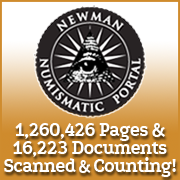
About UsThe Numismatic Bibliomania Society is a non-profit organization devoted to the study and enjoyment of numismatic literature. For more information please see our web site at coinbooks.org SubscriptionsThose wishing to become new E-Sylum subscribers (or wishing to Unsubscribe) can go to the following web page link MembershipThere is a membership application available on the web site Membership Application To join, print the application and return it with your check to the address printed on the application. Print/Digital membership is $40 to addresses in the U.S., and $60 elsewhere. A digital-only membership is available for $25. For those without web access, write to: Terry White, Treasurer AsylumFor Asylum mailing address changes and other membership questions, contact Terry at this email address: terrywhite5475@yahoo.com SubmissionsTo submit items for publication in The E-Sylum, just Reply to this message, or write to the Editor at this address: whomren@gmail.com
BUY THE BOOK BEFORE THE COIN |
- WAYNE'S WORDS: THE E-SYLUM SEPTEMBER 10, 2017
- KOLBE & FANNING HOLDING 20% OFF WEB SALE
- NEW BOOK: GUIDE BOOK OF LINCOLN CENTS, 2ND ED.
- NEW BOOK: TREASURE HUNTING TOP 20TH/21ST CENTURY U.S. COINS
- NEW BOOK: ROYAL COMMEMORATIVE MEDALS, VOL. 4
- NEW BOOK: THE LIBRARY: A CATALOGUE OF WONDERS
- PERIODICAL: CHINA NUMISMATICS 2017.1
- ANS LIBRARY ACQUIRES DUPRé VOLUME
- COLIN R. BRUCE, II (1939-2017)
- NEWMAN PORTAL ADDS FINANCIAL HISTORY
- A LIST OF COIN DATABASE WEB SITES
- THE MYSTERIES OF MARKETING COIN BOOKS
- MORE ON CHARLES J.RICARD
- NOTES FROM E-SYLUM READERS: SEPTEMBER 10, 2017
- THE NEW ORLEANS MINT
- COIN GRADING SERVICE SPECIAL LABELS
- VOCABULARY TERM: SHRINKAGE
- EBENEZER LOCKE MASON, JR. (1826-1901)
- MINT DIRECTOR PHILIP DIEHL AT 2017 DENVER ANA
- CCAC PUBLIC MEETING SEPTEMBER 19, 2017
- INTRODUCING PEOPLE TO COIN COLLECTING
- KAGINS SEPTEMBER 2017 SALE HIGHLIGHTS
- NUMISMATIC AUCTIONS SALE #61 SEPTEMBER 25, 2017
- GORNY & MOSCH FALL AUCTIONS 249-251
- NUMISMATIC NUGGETS: SEPTEMBER 10, 2017
- SELECTIONS FROM THE FEISEL OCTOBER 2017 SALE
- QUERY: HARASSMENT OF THE NUMISMATIST MEDAL
- HAMMERED ENGLISH PENNIES FOUND NEAR CARLISLE
- ROYAL CANADIAN MINT HOT AIR BALLOON COIN
- 'SILVER' PENNY COIN COULD BE RARE ERROR
- LIGHT BRIGADE MEDALS AT AUCTION
- 1642 DUTCH CROWN AMONG ICEBREAKER'S COINS
- $20 'MOVIE MONEY' BILL PASSED IN MISSOURI
- PRESERVING SEPTEMBER 11 ARTIFACTS
- NUMISMATIC TRAVEL QUIZ
- FEATURED WEB SITE: SMALL DOLLARS
Click here to access the complete archive
To comment or submit articles, reply to whomren@gmail.com
Content presented in The E-Sylum is not necessarily researched or independently fact-checked, and views expressed do not necessarily represent those of the Numismatic Bibliomania Society.
WAYNE'S WORDS: THE E-SYLUM SEPTEMBER 10, 2017
This week we open with a numismatic literature sale, four new books, a new periodical issue, and a great acquisition for the ANS Library.
Other topics this week include Colin R. Bruce II, Newman Numismatic Portal updates, the New Orleans Mint, coin grading services and special slab labels, upcoming numismatic auctions, the hot air balloon coin, and a numismatic quiz.
To learn more about Lincoln Cents, Royal Commemorative Medals, Augustin Dupré, coin databases, the Brasher Doubloon, shrinkage, Augustus Humbert U.S. Assay Office $50 gold pieces, a Continental Dollar in tin, encased coins, lexinumiscryptography and the Charge of the Light Brigade, read on. Have a great week, everyone!
Wayne Homren
Editor, The E-Sylum
KOLBE & FANNING HOLDING 20% OFF WEB SALE
Kolbe & Fanning Numismatic Booksellers are holding a 20% off sale on all retail items currently listed on their website at numislit.com. The sale runs from Sunday, Sept. 10 through Saturday, Sept. 16.
The numislit.com website features over 1000 listings of numismatic books, catalogues and periodicals. Users may browse over 20 different categories (Greek, Roman, Byzantine, medieval, modern foreign, medals, U.S., etc.), or may search for specific titles or authors. New publications can be seen, as can new additions to the inventory.
To receive the discount, enter code 20ESYLUM at checkout.
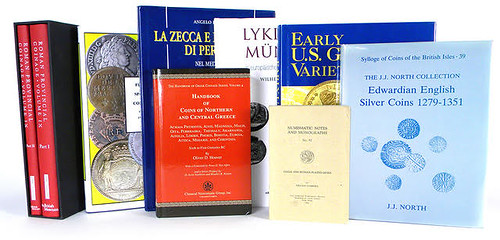
The sale applies to all items currently listed except for subscriptions and gift certificates. Domestic postage via media mail is free on all orders of $100 or more, with orders of $300 or more receiving free domestic priority shipping. Foreign orders will be shipped at cost.
We invite you to take this opportunity to explore our website and see what we have to offer. Visitors to the website may sign up to receive email notifications when new titles are added to particular categories or to be added to our email list.
The sale runs through close of day Saturday, so don’t delay! Visit numislit.com.
NEW BOOK: GUIDE BOOK OF LINCOLN CENTS, 2ND ED.
Whitman Publishing Releases Expanded New Edition of
A Guide Book of Lincoln Cents
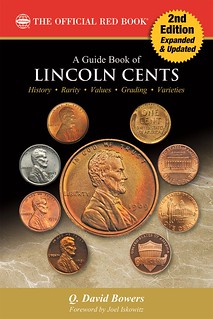 Whitman Publishing has released an expanded, updated second edition of its best-selling Guide Book of Lincoln Cents, a popular entry in the Bowers Series of numismatic titles. The book continues in the tradition of the Guide Book of Morgan Silver Dollars and other Bowers Series guides, now numbering more than two dozen volumes. The 320-page full-color book is available online (including at Whitman.com) and from booksellers nationwide for $19.95.
Whitman Publishing has released an expanded, updated second edition of its best-selling Guide Book of Lincoln Cents, a popular entry in the Bowers Series of numismatic titles. The book continues in the tradition of the Guide Book of Morgan Silver Dollars and other Bowers Series guides, now numbering more than two dozen volumes. The 320-page full-color book is available online (including at Whitman.com) and from booksellers nationwide for $19.95.
Generations of coin collectors have grown up with the Lincoln cent, America’s longest-running coin series, first minted in 1909. Author Q. David Bowers, the nation’s most widely published numismatic writer, provides a detailed study of this American classic, including history, grading, market values, and more. Lincoln cents are illustrated in full color, with high-resolution enlargements for important doubled dies and other varieties. Mintages, specifications, and retail values in multiple grades (including Brown, Red/Brown, and Red Mint State) add to the book’s reference value. More than 750 photographs illustrate the text.
“Lincoln cents are an evergreen coin series,” said Whitman publisher Dennis Tucker. “They’re fun and easy to collect, but they also offer challenges for the advanced hobbyist. Collectors bought tens of thousands of copies of the first edition of the Guide Book of Lincoln Cents. We know the second edition will be just as popular.”
On the technical and production side, A Guide Book of Lincoln Cents covers die preparation, design modifications, the coining process, distribution, Proofs, mintmarks, doubled dies, and other specialized topics. An appendix by specialist Fred Weinberg discusses errors and misstruck cents.
On the market side, the book explains how to specialize in Lincoln cents, and gives advice on determining authenticity, analyzing color and strike, being a smart buyer, realities of the marketplace, comparative rarities, Full Details, certification, establishing fair market prices, and more.
New to the second edition are full coverage of the 2009 cents minted for the bicentennial of Abraham Lincoln’s birth; an appendix on pattern cents; an illustrated overview of Abraham Lincoln medals and tokens, based on the research of historian Fred Reed; a study of Lincoln portraiture from the 1800s to date, also based on Reed’s work; and a gallery of alternative 2009 Bicentennial coin designs that were reviewed by the Citizens Coinage Advisory Committee. The second edition also has a two-page index, and a new foreword by Joel Iskowitz, who designed the 2009 “Professional Life in Illinois” cent. The book has also been updated with new pricing and research. It is 16 pages longer than the first edition.
“Writing this book has been very enjoyable,” author Dave Bowers said. “It has reinforced my continuous belief that Lincoln cents are among the most fascinating coins in the entire American series.”
A Guide Book of Lincoln Cents, 2nd edition
ISBN 0794844189
320 pages, full color
By Q. David Bowers; foreword by Joel Iskowitz
$19.95 retail
“Fascinating reading—Bowers has done an excellent job of putting all of the early minting information in one book, and is to be congratulated for the concise, interesting, yet easy-to-understand information that will be eagerly read by collectors of all coins.” — Professional coin dealer Fred Weinberg
“As usual, Bowers scores a hit again.”
— Numismatist Dr. Sol Taylor
“This book provides unique insight with its detailed facts and figures as well as notes, contemporary articles, and other documentation assembled by the most prolific numismatic author in our lifetime.”
— Lincoln cent expert Charles D. Daughtrey
“Q. David Bowers is a towering figure of great erudition in numismatic literature, and his Guide Book of Lincoln Cents is among the most important works on Lincoln numismatic scholarship.”
— Coin designer Joel Iskowitz
NEW BOOK: TREASURE HUNTING TOP 20TH/21ST CENTURY U.S. COINS
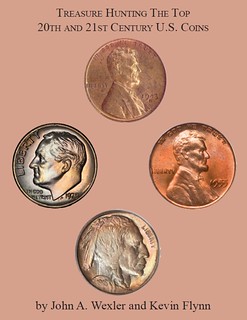 Treasure Hunting the Top 20th and 21st Century U.S. Coins by John Wexler and Kevin Flynn is currently at the printers. This book is being self-published, with only a limited number printed. The book is 8 ½ by 11, 644 pages. Softcover Retail $74.95, Prepublication price is $64.95 plus shipping, which is good until the book is printed.
Treasure Hunting the Top 20th and 21st Century U.S. Coins by John Wexler and Kevin Flynn is currently at the printers. This book is being self-published, with only a limited number printed. The book is 8 ½ by 11, 644 pages. Softcover Retail $74.95, Prepublication price is $64.95 plus shipping, which is good until the book is printed.
This book is an accumulation of over 65 years of die variety analysis and photography by two of the top specialist. Wexler is sometimes referred to as the father of modern die variety. He began publishing Error-Variety News in 1978 and was instrumental in the creation of CONECA. John has written many books and since 1997, he has done a monthly column called Varieties Notebook in Coin World magazine. John is recognized as one of the top macro-photographers in the field, especially on proof die varieties.
Flynn started writing numismatic books around 1990 and has since written 52 coin books, covering many U.S. coin series, including the majority of the 20th century series. The majority of these books present the die varieties for the series; with many also covering the national archive records, historical information, design and other changes, and any of the fascinating stories and lure of a series. Both Flynn and Wexler have strived to do a full and complete analysis of each of the die varieties, including whether they are valid, such as the refuted 1914/3 Buffalo nickel.
This book covers the top coins for each series. In the Introduction of each series presents the history of the series, lists the rare dates, and covers all hot topics. For example, included in the Lincoln cents: the refuted 1951-D/S and 1952-D/S; 1964 SMS; 1922 No D; 1990 No S Proof; 1943 Bronze cent; 1944 Steel cent; and 1974 Aluminum cent. The die variety section for each series lists the top overdates, doubled dies, RPMs, OMMs, and clashed varieties. For some series such as the Peace Dollars, other types of the varieties covered include major die cracks and other types of varieties.
Each variety includes a detailed description, all die stages and diagnostics, and pricing; many include additional comments that present information about the variety, how it was made, or pertinent facts that can assist in understanding more about the variety. Each part of the variety is shown in detailed macro photographs making identification simple. Many of the macro-photographs in this book for the die varieties are second to none and some of these varieties are listed in no other books.
Prepublication price for the softcover is $64.95 plus $5 for media shipping or $10 for first class shipping.. To order, send a check or money order to Kevin Flynn, P.O. Box 936, Troy, VA 22974. Paypal is also accepted, please write first to kevinjflynn88@yahoo.com
NEW BOOK: ROYAL COMMEMORATIVE MEDALS, VOL. 4
Royal Commemorative Medals 1837-1977. Vol. 4.
Edward VII, 1901 - 1910.
By John Cumbers and Andrew Whittlestone, edited by Paul and Bente R Withers.
2nd edition, 2017 PB A4 (210 x 297mm) 205 pages.
 This new, improved and much-expanded edition, with glossy card cover, is illustrated throughout, with
many hundreds of high-quality colour photographs, including many of the different suspension types and
ribbons.
This new, improved and much-expanded edition, with glossy card cover, is illustrated throughout, with
many hundreds of high-quality colour photographs, including many of the different suspension types and
ribbons.
There are indexes of Obverse and Reverse legends, Makers, Designers, Die-cutters and publishers, and an index of registered design numbers, as well as a General index, so as to make finding a particular medal easy. There is a concordance with Brown's British Historical Medals, and a list of number changes since the first edition.
All entries have rarity ratings and prices.
Price £50 including UK postage (tracking and insurance extra)
£60 including postage to Europe (tracking and insurance extra)
£65 including postage to USA (tracking and insurance extra)
NEW and available only from GALATA. Available from around the middle of October in time for the Token Congress. Advance orders are now being taken.
Paul adds:
It is much expanded, has valuations and rarities, and now has colour illustrations throughout. The book is currently with the printers and will be available around the middle of October so that those who have ordered in advance will be able to collect it from us at the Token Congress bourse.
For more information, or to order, see:
Royal Commemorative Medals 1837-1977. Vol. 4. Edward VII, 1901 - 1910.
(http://www.galata.co.uk/store.asp?storeAction=showDetail&stockID=10703)
To read the earlier E-Sylum article, see:
NEW BOOK: ROYAL COMMEMORATIVE MEDALS 1837-1977. V3
(http://www.coinbooks.org/esylum_v18n20a03.html)
NEW BOOK: THE LIBRARY: A CATALOGUE OF WONDERS
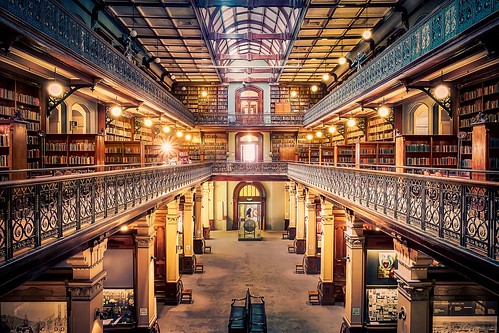
I recently had the privilege of circling the world to write a book about libraries. My timing was excellent: after a short-lived e-books scare, physical books are back in fashion, and libraries are the place to be.
My trip was not unlike the pilgrimages made by 18th-century library tourists. On my journey I noticed two trends that are changing how we think of old books and old libraries.
The first is a stronger focus on provenance research. Through whose hands have the books passed? How did those handlers use and mark and protect their books? This branch of bibliography is helping to humanise it.
The other trend involves breaking away from traditional ideas of what constitutes a meritorious book, and from the traditional oppositions of high and low literature. Thanks to this, pulp novels – featuring what Allen Lane called “bosoms and bottoms” cover art – have infiltrated rare book collections. Crime pulps and sci-fi paperbacks are now prized by such hallowed institutions as the Smithsonian, the Houghton and the British Library.
The history of libraries is rich with metaphors of books as lovers, prisoners, weapons, potions and creatures. It is also rich with real, non-metaphorical creatures. Much is known about the ecosystems and biodiversity of libraries. Library fauna such as bookworms, bedbugs and microbats have long been the subject of study. But a little-known subfield concentrates on the human biology of libraries.
When Sylvia Plath vengefully incinerated Ted Hughes’s personal papers, she sprinkled in his dandruff and fingernail cuttings. The Australian bookbinder and bibliophile Richard Griffin, after crashing his car into a tram, famously bled on many of his most precious books (Griffin’s girlfriend tried to drown some of the others in the bath).
Seventeenth-century books are now being searched for the DNA of Shakespeare – or perhaps of Francis Bacon, Henry Neville or Edward de Vere – to resolve the so-called Authorship Question. DNA testing has also been used in libraries to identify materials used in book-making. (French books covered with the skin of guillotined prisoners were said to be bound in “aristocratic leather”.)
To read the complete article, see:
Blood, bookworms, bosoms and bottoms: the secret life of libraries
(https://www.theguardian.com/books/2017/aug/27/blood-bookworms-bosoms-and-bottoms-the-secret-life-of-libraries)
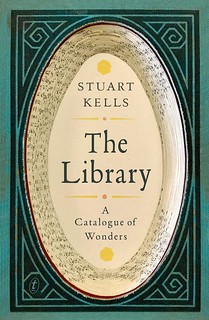 Libraries are filled with magic. From the Bodleian, the Folger and the Smithsonian to the fabled libraries of middle earth, Umberto Eco’s mediaeval library labyrinth and libraries dreamed up by John Donne, Jorge Luis Borges and Carlos Ruiz Zafón, Stuart Kells explores the bookish places, real and fictitious, that continue to capture our imaginations.
Libraries are filled with magic. From the Bodleian, the Folger and the Smithsonian to the fabled libraries of middle earth, Umberto Eco’s mediaeval library labyrinth and libraries dreamed up by John Donne, Jorge Luis Borges and Carlos Ruiz Zafón, Stuart Kells explores the bookish places, real and fictitious, that continue to capture our imaginations.
The Library: A Catalogue of Wonders is a fascinating and engaging exploration of libraries as places of beauty and wonder. It’s a celebration of books as objects and an account of the deeply personal nature of these hallowed spaces by one of Australia’s leading bibliophiles.
For more information, or to order, see:
The Library: A Catalogue of Wonders
(https://www.textpublishing.com.au/books/the-library-a-catalogue-of-wonders)

PERIODICAL: CHINA NUMISMATICS 2017.1
RESEARCH ON MONETARY HISTORY
Research on the forms of money used in land transactions among the ordinary people in Hubei province in the 19th and early 20th century
Research on the [Japanese] Central Bank of Manchuria’s reserves
Currency war in Qingdao and the surrounding area during the War of Resistance against Japan (Part 2 of Currency invasion and currency war in Qingdao and the surrounding area during the War of Resistance against Japan)
NUMISMATIC FORUM
Calligraphy on Xi Xia coins: evolution and distribution
The Qing dynasty Yusu official monetary bureau and the paper money it issued
Conservation of coins found in the sea, taking copper coins from Nanhai One as an example
EXCAVATION AND DISCOVERY
Another piece of Chu gold (Warring States) found in Linquan, Anhui province
A bond of the Fujian-Zhejiang-Jiangxi soviet
FOREIGN COINS
On the CFA franc past and present [Africa]
BOOKS
New publication: Paper Money of Yunnan
Review by Zhou Xiang (Shanghai Museum) of Scientific Research on Chinese silver ingots, by Zhou Weirong et al.
NEWS
Mr Ma Yanjun donates ancient coins to the China Numismatic Museum
Mr Zhang Han (1920-2017)
Paper Money of Yunnan — The third in the Standard Illustrated Catalogues of Chinese Paper Money series, based on materials collected, sorted and studied by Fan Changming and Su Jun over almost thirty years. It’s the first time notes have been arranged by province and region, and ranges from the Qing dynasty to the Republican period. [Fan Changming and Su Jun, Yunnan zhibi, Yunnan renmin chubanshe, 2017, ISBN 978-7222-150508
For more information, or to order, see:
http://www.cqvip.com/QK/82320X/201701/671447972.html
To read the complete article, see:
CHINA NUMISMATICS 2017.1 (144) – ENGLISH SUMMARY
(https://chinesemoneymatters.wordpress.com/2017/09/04/china-numismatics-2017-1-144-english-summary/)
ANS LIBRARY ACQUIRES DUPRé VOLUME
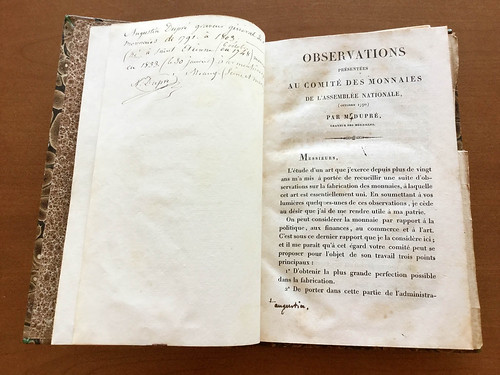
ANS Library Acquires Volume of Rare Pamphlets from the Library of Augustin Dupré
From a recent Kolbe & Fanning auction, the ANS Library has acquired a bound volume of three pamphlets by renowned artist and engraver Augustin Dupré, famed for his work on French coins and for his designs of early U.S. medals, particularly the Libertas Americana.
The volume is from Dupré’s own library. The pamphlets date from the period of the French Revolution and concern the redesign of coinage during the revolutionary era. Some of the proposals suggested by Dupré in one of the pamphlets (Observations Présentées au Comité des Monnaies de l'Assemblée Nationale, 1790) were adopted, and in 1791 he was appointed Graver général des monnaies.
His management methods and coin designs came up for some criticism during the politically tumultuous time, and another pamphlet in the volume (Réponse à l'écrit de M. Beyerlé, 1791) has him mounting a defense against these attacks. The third pamphlet (Observations Rélatives au Mémoire que la Commission Générale des Monnoyes, 1793) is a response to an official report on the redesign of coinage that had been submitted to the revolutionary government, thus providing a window into the artist’s beliefs. We would like to thank ANS Fellow David Gladfelter for contributing to the purchase of the volume.
COLIN R. BRUCE, II (1939-2017)
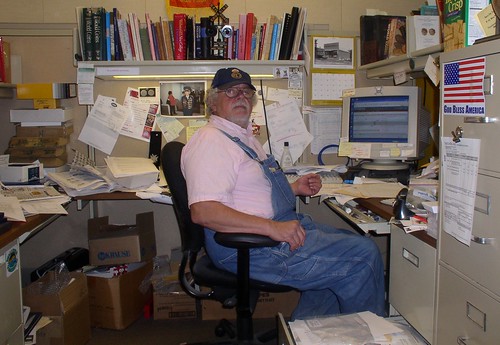
Colin in his office at Krause Publications (Image courtesy George Cuhaj)
Colin R. Bruce, II Succumbs to Cancer
Colin R. Bruce, II, long-time editor and author at Krause Publications, succumbed to cancer on Sunday, September 3, 2017, at Iola Living Assistance following an extended fight with the disease. He was 77 years old. Raised in the Buffalo area of upstate New York, he had been a resident of Iola, Wisconsin, since 1974, having served as a member of the world coin and paper money cataloging staff from then until his retirement in 2008.
Bruce was especially interested in and knowledgeable of the numismatic issues of Mexico, China, Japan, and the Indian Princely States. Through the years he developed an international network of enthusiasts and experts in wide-ranging specialty areas, through both his staff and pre-Krause involvements as a part-time dealer operating out of North Tonawanda, N.Y., upon whose expertise he successfully built to grow and refine the “Standard Catalog” reference line.
“Colin Bruce was an outstanding cataloger of world numismatic issues,” former Krause Publications president Clifford Mishler observed. “He was, in my opinion, in a global sense, the most outstanding numismatic cataloger of his era."
“Colin was to the world coin and paper money collecting disciplines what R. S. Yeoman was to the United States coin field a couple generations before,” Mishler continued. “He was tirelessly dedicated to expanding the realm of knowledge available to collectors for fostering their development in, and resulting benefits realized from pursuit of the world collecting realm.”
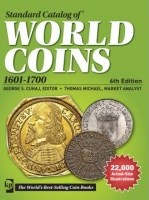 A major specialist contributor to the first and second editions of the Standard Catalog of World
Coins (Krause-Mishler), published in 1972 and 1973, Bruce came on board at Krause
Publications in 1974 and spearheaded publication of the third edition in 1975 as its editor. He
was the lead cataloger and editor of all subsequent editions published annually through the 35th
published in 2007, during which time it expanded from a single volume reference of about 1000
pages, to a massive five-volume set comprising a combined 6000-plus pages, covering all
issues from the early 17 th century to the early 21 st century.
A major specialist contributor to the first and second editions of the Standard Catalog of World
Coins (Krause-Mishler), published in 1972 and 1973, Bruce came on board at Krause
Publications in 1974 and spearheaded publication of the third edition in 1975 as its editor. He
was the lead cataloger and editor of all subsequent editions published annually through the 35th
published in 2007, during which time it expanded from a single volume reference of about 1000
pages, to a massive five-volume set comprising a combined 6000-plus pages, covering all
issues from the early 17 th century to the early 21 st century.
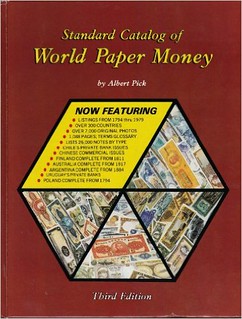 Bruce similarly served as the lead cataloger and founding editor of the Standard Catalog of
World Paper Money (Pick), the first edition of which appeared in 1975, and of the ongoing
editions that appeared prior to his retirement. That original 720-page reference grew to become
a three-volume set – dedicated to General Issues, Modern Issues, and Specialized Issues – that
embraced some 4000 total pages.
Bruce similarly served as the lead cataloger and founding editor of the Standard Catalog of
World Paper Money (Pick), the first edition of which appeared in 1975, and of the ongoing
editions that appeared prior to his retirement. That original 720-page reference grew to become
a three-volume set – dedicated to General Issues, Modern Issues, and Specialized Issues – that
embraced some 4000 total pages.
He was also responsible for the content and appearance of several specialized country and regional catalogs, drawn from consultant relationships and the Standard Catalog coin and paper money databases, that were published in the intervening years. Multitudes of varieties and dates of known coinage types, generally unrecognized except by specialized scholars, were first chronicled for the collecting universe as a result of his digging.
Bruce also found time to assemble and organize the diverse universe of non-governmental “coin” issues for publication of the popular Unusual World Coins, a title first published in 1987. He also authored numerous specialized articles and features published from time to time in World Coin News and the Bank Note Reporter over the years.
“From the mid-1970s onward, the materials compiled and published under Colin’s direction were a major contributor to the great expansion of collecting interest, pursuit and satisfaction in the world coin collecting realm from the early 1600s onward into the 21st century,” Mishler observed. “His capabilities in unraveling the often mysterious and challenging issues of Southeast Asia, which were of particular merit for the first two editions of the SCWC, first connected Chet Krause and myself with him.”
A lifelong coin collector, Bruce had first become an aficionado of the coins of Mexico while serving in the United States Army (1962-65) and based in El Paso. He subsequently became enamored with the challenge of understanding and gathering the coins and paper money issues of Japan, and China, along with the offerings of other Asian countries. His appreciation and understanding of all world numismatic issues spread much broader afield.
“Colin’s passing will certainly be missed by all who made his acquaintance along the line, but particularly so by those of us who worked beside and with him in pursuing enlightenment of the world numismatic realm,” Mishler concluded. “He and his contributions will be long remembered by us all.”
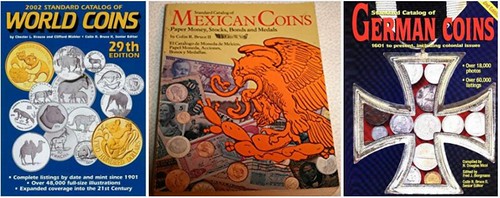
George Cuhaj adds:
Some of his other publications were:
Standard Catalog of German Coins, (several editions) edited with N. Douglas Nicol,
Standard Catalog of South Asian Coins and Paper Money, 1982 with William Spengler,
Collecting World Coins,
World Gold Coins,
Modern World Gold Coins, and
Standard Catalog of Mexican Coins, Paper Money, Bonds and Medals
How E-Sylum readers can help
George adds:
Colin had been cremated. There is a memorial service at 7 PM on Tuesday Evening September 12, 2017 with visitation from 6-7 PM at Voie's Funeral Home in Iola, Wi. In leu of flowers please consider the instructions below.
His protracted illness had a devastating impact on Colin and his wife Kandy. Subsequent to his death, Kandy is faced with severe financial hardship. Over the years, Colin may have mentioned to some of you how he and Kandy provided a home for a multitude of abandoned “critters”. Kandy is now faced with the continued care of 20+ cats – her beloved family. Kandy’s struggles will continue for some time. Please honor your memory of Colin – or your love of animals – by sending your financial support to: Kandy & the Kitties c/o Randy Thern, P.O. Box 433, Waupaca, WI 54981. Please forward this message to anyone you can. Or via Paypal to randy@signaturesintime.com via the "Friends & Family" link so that Paypal fees are not removed.
NEWMAN PORTAL ADDS FINANCIAL HISTORY
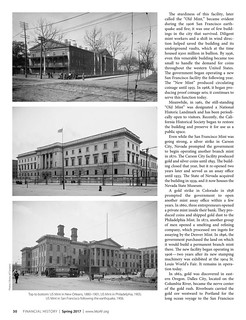 Financial History, the quarterly publication of the Museum of American Finance, has been added to the Newman Portal. Published since 1978, Financial History is a rich source of economic history often featuring numismatic connections. The Spring 2017 issue featured Michael Martorelli’s “Cathedrals of Coinage” (a history of US Mint locations), while the Summer 2016 issue included an article by National Numismatic Collection Curator Ellen R. Feingold on “Women and Money,” featuring women on coins and paper money. The Museum of American Finance is an overlooked numismatic destination in New York, conveniently located in Manhattan at 48 Wall Street, and well worth visiting.
Financial History, the quarterly publication of the Museum of American Finance, has been added to the Newman Portal. Published since 1978, Financial History is a rich source of economic history often featuring numismatic connections. The Spring 2017 issue featured Michael Martorelli’s “Cathedrals of Coinage” (a history of US Mint locations), while the Summer 2016 issue included an article by National Numismatic Collection Curator Ellen R. Feingold on “Women and Money,” featuring women on coins and paper money. The Museum of American Finance is an overlooked numismatic destination in New York, conveniently located in Manhattan at 48 Wall Street, and well worth visiting.
The Newman Portal acknowledges Kristin Aguilera, Deputy Director of the Museum of American Finance, and David Hill, American Numismatic Society Librarian, for their assistance with this project.

Eva Perón on a 100 peso note, Argentina, 2012,
from Financial History #118 (Summer 2016).
Link to Museum of American Finance:
https://www.moaf.org/
Link to Financial History on Newman Portal:
https://nnp.wustl.edu/library/publisherdetail/519588
A LIST OF COIN DATABASE WEB SITES
While we prioritize sites in English, other languages are welcome if the sites contain good information. Here's a listing of coin database sites. Let me know what you think of these, and if there are any major sites you think are missing and ought to be included.
For a site to be considered a database, there has to be a pretty formal structure to the data presented. Plenty of sites have great information, but they are more like online books than structured databases. I have a separate category for Information sites (and a subset of those are Collector sites, where the author is primarily displaying their own collection).
Anyway, let me know your thoughts on these, and any others you think should be added. Thanks. -Editor
Coins
Online Greek Coinage
Sylloge Nummorum Graecorum
Wildwinds
Ancient Coin Search Engine
Oriental Coins Database
World Coin Gallery
CoinHelp!
Newman Numismatic Portal
PCGS CoinFacts
Roman Provincial Coinage project
Seated Dime Varieties
Medals
Historic Art medals
Medallic Art Collector
KarlGoetz.com
ExpoMedals.com
Medal Artists
Paper Money
World Banknote Gallery
The National Bank Note Census
Tokens
World Token Gallery
Exonumist.com
Token Catalog
Other
Coin History
Coin Archives
Coin Sheet
Numismalink
Pinterest: COINAGE?MEDALS?TOKENS?MONEY
Pinterest: Explore Banknotes, Tokens and More
To visit the Newman Numismatic Portal, see:
https://nnp.wustl.edu/
To read the earlier E-Sylum articles, see:
A LIST OF COIN BLOG WEB SITES
(http://www.coinbooks.org/v20/esylum_v20n30a28.html)
A LIST OF COIN FORUM WEB SITES
(http://www.coinbooks.org/v20/esylum_v20n31a14.html)
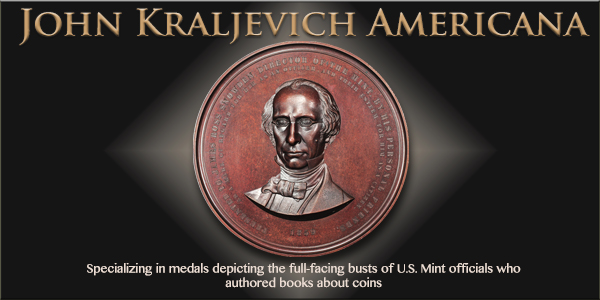
THE MYSTERIES OF MARKETING COIN BOOKS
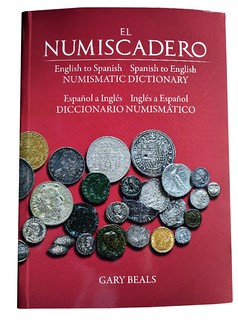 A funny thing happened after a fine 1/3rd page article reviewing my coin dictionary Numiscadero in the March, 2017 issue of The Numismatist appeared:
A funny thing happened after a fine 1/3rd page article reviewing my coin dictionary Numiscadero in the March, 2017 issue of The Numismatist appeared:
Nothing.
Not a single inquiry about ordering a copy from any member of the American Numismatic Association’s 24,000-some collectors and dealers. The only connecting point was my e-mail address at the end of the article, so my first thought was that something was mis-printed on it: Segovia.gary@Yahoo.com — nope, it was just the same address as was using in my mailings between editor Cynthia Wood-Davis and myself. Anyone interested in owning a copy of the book would first need to pop me a short e-mail. Too tough a process?
The e-mail was the launching point for new orders: Send me an e-mail and I will send you the payment process with CitiBank via check or direct deposit. Pretty simple — $25 plus $3 postage and handling for a 352-page numismatic dictionary. Provide a mailing address and we will send the book on its way — often even before payment is received.
I am quite pleased with the book as a legacy between the 85-page book I produced as a college kid in 1966 and this modern age.
But the book market in general has been changing in many ways in recent years. Gary shared his experience with Dick Johnson, who submitted the following thoughts. -Editor
IS THE ERA OF THE BIG NUMISMATIC LIBRARY DEAD?
Gary Beals’ lament that his book didn’t sell as expected is evident of the current situation with highly specialized numismatic books. One. The era of the book collector who wants one of every book no longer exists. Two. Modern living does not provide space for a great many book shelves built in a home or office. Three. Organizations, like ANS and ANA, are stressed in their book buying budgets, preferring instead to wait for each new book to be donated, either by the author, or by some benefactor.
Gone are the years like in the 18th century where maybe one book of numismatic interest in America was published in a decade. Or in the early 19th century when one or two were published a year, maybe by as many as a dozen by midcentury. Or, say 30 a year after World War II and leisure time gave rise in numismatic activities, including writing and publishing books. Now perhaps 150 new numismatic books are offered every year as specialized interested expands.
Gary fell into the trap of ordering too many initial books, 1,000 copies. I admit I did the same with my first book, on artists' monograms. I ordered 300 copies from a regular printer. I sold 50 and now sitting on 250 in storage, knowing that a few will sell a year, for 50 years, hopefully before the copyright expires.
There is the allure of a lower unit cost as the volume increases. “The books will cost $2.50 less if you order 500 more copies.” You can hear the printer‘s salesman. The printer makes more money by longer pressruns (at your expense).
I am a strong advocate for print-on-demand. I used this for my other two books. Granted you have to do more work. You must do everything in addition to writing -- design the covers, prepare all the illustrations, chose all type faces. You must furnish camera ready copy. You can order any quantity printed. They will even market it for you – to their usual book outlets. You must do specialized marketing yourself.
For my second book on American medallists, I omitted their marketing service, but took 100 initial books which I would market myself. I reordered twice after that. At no time did I have more than 50 copies on hand – no storage problem. You must send that camera-ready copy again – but this is good – it gives you a chance to correct any pesky typos and errors.
Hints: Hire an editor to check your copy. The editor points out bad writing “delete this,” “rewrite this,” sometimes catches technical errors – worth the cost to have a second pair of eyes. Also recommends eliminating bad features, like a recent book that had the text in changing colors. Just because your computer has dozens of colors available doesn’t mean you have to use them in one book. Another hint: You may also want help in designing the book, both text and covers.
I hope I haven’t discouraged anyone from writing a book. If you have formed a collection of some numismatic series or topic, and there is no existing book on that subject, be the first to do so. Good Luck.
To read the earlier E-Sylum articles, see:
NEW BOOK: EL NUMISCADERO
(http://www.coinbooks.org/v20/esylum_v20n03a02.html)
BOOK REVIEW: EL NUMISCADERO
(http://www.coinbooks.org/v20/esylum_v20n20a05.html)
MORE ON CHARLES J.RICARD
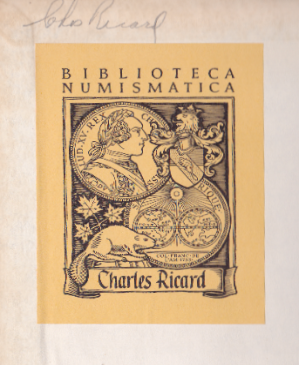 Attached is a scan of a lovely book plate of “Charles Ricard” with a distinctly Canadian theme, and above it, his signature in pencil.
Attached is a scan of a lovely book plate of “Charles Ricard” with a distinctly Canadian theme, and above it, his signature in pencil.
The TAMS Journal article referred to by David Alexander, illustrating the unique 1960 medal of Charles J. Ricard as Napoleon, was actually a special Journal issue published in 1972 about the life and work of the Rochester, New York, medallic engraver and sculptor Alphonse A. Kolb, M.A. and was written by Ricard himself. In it he writes, speaking of himself in the third person: “Due to his interest in Napoleonic medals, a special medal was engraved with a Napoleonic likeness, by Mr. Kolb, and was presented to Mr. Ricard in 1960.”
Kolb struck 51 of the 60 presidential medals of the Rochester Numismatic Association issued through 1972, including his self-portrait presidential medal in 1931. He also struck two A.N.A. convention badges, the 20th anniversary medal for the Buffalo Numismatic Association, and a variety of other medals including the 1934 centennial medal of the city of Rochester. Ricard’s article also illustrates a number of Kolb’s sculpted plaques, including a signed likeness of George Washington used by Bastian Brothers Co. of Rochester on 11 of their Washington Bicentennial medals. A full page photograph of Kolb’s studio concludes the 56 page special issue.
Marc C. Ricard writes:
Thank you so much for the great memory of my father. You are correct, that is my father's book plate. He usually only plated his finest books, some of which are now in the libraries of noted numismatists. The bookplate itself depicts a French medallion of Louis XV. In the upper right corner is the Ricard family coat of arms, and a larger beaver lower left that reflects our French-Canadian heritage. The signature in the photo is not my father's, as it is missing the "Catholic cursive small r" which was clearly recognizable in all of his signatures.
David Gladfelter adds:
The medal on the book plate is Breton 513, of which 6 varieties were known to him, probably more today. This particular book came to me via the library of Armand Champa, certainly a noted numismatist. It is a well-bound and serviceable copy of the American Numismatic Society's 1920 reprint of The State Coinages of New England (Connecticut by Miller, and Vermont and Massachusetts by Ryder). It lacks the 6 page addenda but I've laid that in. Your dad must have enjoyed colonials.
To read the earlier E-Sylum articles, see:
CHARLES J. RICARD (1930-2017)
(http://www.coinbooks.org/v20/esylum_v20n35a05.html)
REMEMBERING CHARLES J. RICARD
(http://www.coinbooks.org/v20/esylum_v20n36a12.html)
NOTES FROM E-SYLUM READERS: SEPTEMBER 10, 2017
Reader Comments on The E-Sylum
Duane Feisel of Shingletown, CA writes:
Thanks for everything you have done and are doing – very professional and so informative, interesting, and educational. Quite a publication!
Bill Blystone writes:
I enjoy your publication. As an old time collector it amazes me the amount of new info which has come to light in the last 20-odd years. What did we do before computers?
The Auction '79 Brasher Doubloon Sale
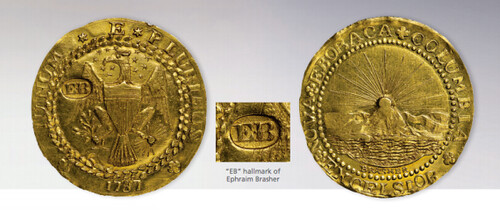
Reading David Alexander's story about the Apostrophe Sales brought back many memories. As the Vice President of Rarcoa I had an active relationship with the sales from the beginning. I also catalogued our section in the beginning and was the auctioneer for the major portion of the sales working not only Rarcoa's section but also for David Akers and Stack's until the end.
While there are many stories about the sales, one stands out as the best. In Auction '79 Rarcoa sold Jack Freidberg's Brasher Doubloon, the first to be sold in over 50 years. The Doubloon's sale drew wide attention including live national TV coverage. This is the first I have talked about what happened during the actual sale. While many were interested in buying the coin, it came down to just two bidders, neither of which anyone in the room could know were bidding.
Prior to the sale one bidder had told me he would be bidding as long as he had his pen in his shirt pocket. He sat at the end of the front row to my left with John J. Ford next to him. As the bidding progressed several bidders dropped out and two were left. The ultimate buyer, Walter Pershke, was seated in the second row directly in front of me and was bidding by only holding up a pen in his lap.
No one could see either bidder, including Ed Milas sitting at my left on the podium working the book. He got very excited and kept asking who was bidding, even Don Kagin stood up on a chair in the back of the room trying to see the bidders. Margo Russell was standing behind the podium with a camera and was the only other person that saw that Walter was bidding. The underbidder finally removed his pen from his pocket and it was over with a new World Record price having been attained. It was the most exciting auction moment I can recall prior to the selling Leon Hendrickson's 1804 Dollar.
To read the earlier E-Sylum article, see:
THE APOSTROPHE SALES: 1978-1990
(http://www.coinbooks.org/v20/esylum_v20n36a06.html)
The Third Degree Knicker Pie Eaters Club Token
Tom Casper of
Muskego, WI writes:
I enjoyed the article in the last E-Sylum issue about the Third Degree Knicker Pie Eaters Club token. I'm sorry I missed the ANA show in Denver to see this exhibit. I have had that token in my "What's Its" box for many years without knowing the story behind it. The piece is copper and 35mm. I am sending scans of the piece for a close-up view of it. It's in rough shape but it is the only one I have ever seen.
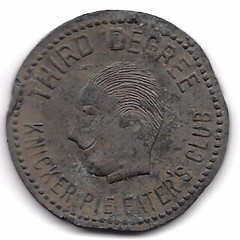
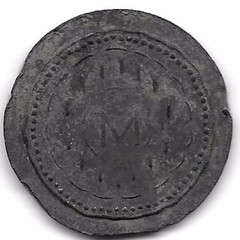
To read the earlier E-Sylum article, see:
THE THIRD DEGREE KNICKER PIE EATER’S CLUB
(http://www.coinbooks.org/v20/esylum_v20n36a29.html)
Charles J. Ricard TAMS President Medal
Former U.S. Mint Sculptor/Engraver Tom Rogers of Beatty, OR writes:
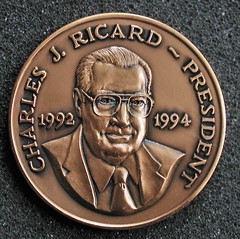 I was sorry to hear in your last issue, of Charles J. Ricard's passing.
A very nice, and knowledgeable man....I did this portrait for him many years ago to commemorate his Token and Medal Society Presidency.
I was sorry to hear in your last issue, of Charles J. Ricard's passing.
A very nice, and knowledgeable man....I did this portrait for him many years ago to commemorate his Token and Medal Society Presidency.
For more information on Tom and his work, see:
http://www.tdrogers.com/
To read the earlier E-Sylum articles, see:
REMEMBERING CHARLES J. RICARD
(http://www.coinbooks.org/v20/esylum_v20n36a12.html)
More On Deceptive Colonial Counterfeits
Alan Weinberg writes:
Relative to Jack Young's discovery of the 1787 4c Mass half cent being counterfeit, I note telltale spark erosion raised pimples to the left of the arrow feathers left of O in Common and on the reverse to the left of the eagle spread wing. These same telltale pimples appeared on a choice EF Noe 16 Pine Tree 1652 Massachusetts shilling featured in color on the cover of a Dix Noonan Webb Auction catalogue of a few months ago featured in The E-Sylum. The coin was pulled from the auction once I and John Kraljevich notified DNW of the coin's spurious nature. Subsequently a prominent US coin dealer called me and told me he had paid $4K for the Pine Tree shilling and he was no stranger to colonial coins.
These deceptive colonials remind me very much of the spark erosion-produced rare US colonials which were the subject of Eric Newman's April 1979 Numismatist feature article Superb Numismatic Forgeries , several of which made it into a Bowers and Ruddy ANA auction and were withdrawn. These forgeries appeared to be the same process used to forge 8 or 9 George Washington inaugural buttons recently sold by a prominent antique button firm in good faith, the group purchased for almost $10K by me and subsequently returned and refunded.
It seems to me that a simple 5x glass search for these telltale pimples and examination of the questionable coin's rim or edge and how it SHOULD look on a genuine piece are the keys to avoid being taken. Forgers have not yet perfected duplicating what a genuine edge should look like ( i.e. beveled or rounded, etc ) and have not conquered the tiny raised pimples.
To read the earlier E-Sylum article, see:
COUNTERFEIT 1787 MASSACHUSETTS “4C” HALF CENT
(http://www.coinbooks.org/v20/esylum_v20n36a20.html)
Teaching Young Rascals to Become Amateur Counterfeiters
Dick Johnson writes:
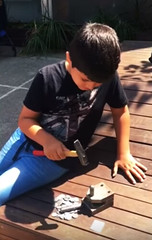 To teach children how to make facsimile and replica coins – to educate them how coins are made – is an unwise activity. It results in their handiwork turning up in the future causing confusion as long as these items exist, as mentioned in last week’s E-Sylum. This will continue until the last of these items are destroyed.
To teach children how to make facsimile and replica coins – to educate them how coins are made – is an unwise activity. It results in their handiwork turning up in the future causing confusion as long as these items exist, as mentioned in last week’s E-Sylum. This will continue until the last of these items are destroyed.
I experienced this when, as curator of the Belskie Museum, I was notified such a class would be conducted at the Museum to about a dozen youngsters. My comment that such instruction is teaching young rascals to become amateur counterfeiters, fell on deaf ears of the Museum directors. They insisted in offering the class to receive an youth educational grant!
To read the earlier E-Sylum article, see:
'ANCIENT SHEKEL' FIND IS ONLY A FACSIMILE
(http://www.coinbooks.org/v20/esylum_v20n36a15.html)
Silver-clad Carnegie Hero Fund 100th anniversary medal
Ron Thompson of
Decatur, GA writes:
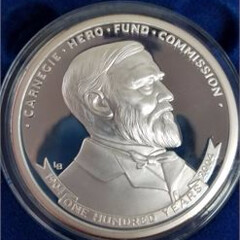 Regarding the 2004 Carnegie Hero Fund 100th anniversary medal, last week's E-Sylum reported the medal as silver, but the literature says “It is 2.5 inches in diameter and struck in silver-clad bronze. The silver plating is of .999 grade, and the bronze used in both medals is an alloy of 85% copper and 5% each of zinc, tin, and lead.” Apparently there was planned a bronze medal as well as a silver-clad medal. I have only seen the silver-clad.
Regarding the 2004 Carnegie Hero Fund 100th anniversary medal, last week's E-Sylum reported the medal as silver, but the literature says “It is 2.5 inches in diameter and struck in silver-clad bronze. The silver plating is of .999 grade, and the bronze used in both medals is an alloy of 85% copper and 5% each of zinc, tin, and lead.” Apparently there was planned a bronze medal as well as a silver-clad medal. I have only seen the silver-clad.
To read the earlier E-Sylum article, see:
PAN AUCTION CLOSES OCTOBER 27, 2017 : 2004 Carnegie Hero Fund 100th anniversary medal
(http://www.coinbooks.org/v20/esylum_v20n36a23.html)
Baseball's Elysian Fields
Scott Miller writes:
I read the last issue and saw the entry on Elysium. The Elysian Fields (Hoboken) are also known as the site of what might be the earliest organized baseball game - see http://xroads.virginia.edu/~hyper/incorp/baseball/origins.html and http://www.hobokenbaseball.com/
To read the earlier E-Sylum article, see:
NOTES FROM E-SYLUM READERS: SEPTEMBER 3, 2017 : Elysium
(http://www.coinbooks.org/v20/esylum_v20n36a13.html)
THE NEW ORLEANS MINT
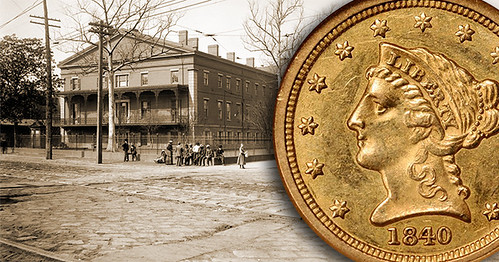
New Orleans, Louisiana, was the home of a branch mint of the United States from 1838 to 1861, when it was closed following the outbreak of the American Civil War. It reopened in 1879 and forever closed its doors as a mint in 1909. During its two stints producing coinage it struck a wide variety of denominations, ranging from the small three-cent silver piece to the large $20 gold piece. Quarter eagles were produced at this mint only during the pre–Civil War era, as quarter eagle production was mostly at the Philadelphia Mint after 1879 (with a few exceptions). The mint building is still standing to this day and currently houses the Louisiana State Museum. It was built in red brick and designed in the Greek revival style popular at the time it was constructed.
Due to its location and status as a trade port, New Orleans was selected in the 1830s as one of three locations to have a branch mint (Charlotte and Dahlonega were both located close to major gold fields). The city’s strategic location, its size (it was the fifth-largest city in the United States prior to the American Civil War), and its active trade meant that it was a perfect spot for a branch mint. In addition, large supplies of metal flowed through the city, much of which came from (former) Spanish colonies in Central America, so getting the gold and silver required for coinage was not a problem. The mint opened in 1838, and during many years it had a very large output of coins, sometimes surpassing the Philadelphia Mint in production figures.
 New Orleans Mint Stamping Room
New Orleans Mint Stamping Room
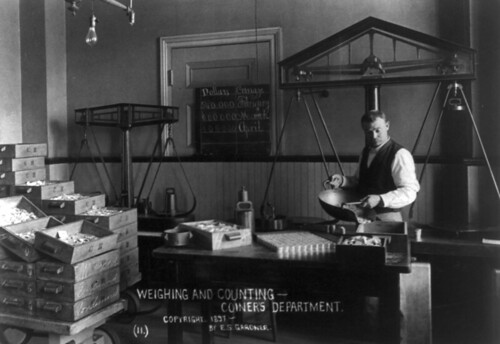 New Orleans Mint Weighing and Counting Room
New Orleans Mint Weighing and Counting Room
To read the complete article, see:
The New Orleans Mint’s Liberty Quarter Eagles
(http://news.coinupdate.com/the-new-orleans-mints-liberty-quarter-eagles/)

COIN GRADING SERVICE SPECIAL LABELS
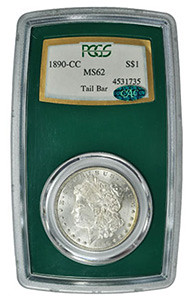
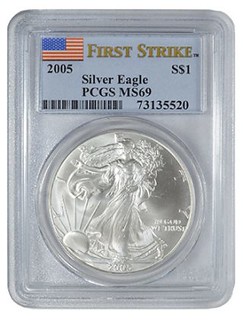
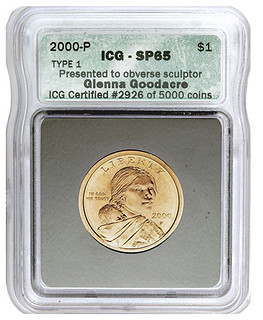
Buy the coin, not the slab.
This is wise guidance, and a prudent collector needs to do more than read the numbers on a holder before deciding whether to buy. At the same time, it is accurate to say that a collector buys both the coin and the slab. In addition to buying the certification service’s reputation and a numeric grade, the coin buyer purchases the holder as a physical object.
Grading service special labels enhance and differentiate that hybrid object, serving a function beyond recording the coin’s authenticity and condition.
The Postmodern Era
American numismatics has entered the postmodern era of coin grading. In the premodern period before certification not so long ago, the grade was a general opinion agreed upon by the buyer and seller, negotiated anew with each purchase.
The modern era began with photo certificates in the 1970s and slabs in the ’80s. This is when the grade on the major service label became–while not infallible–impartial and well-informed, the judgement of a generally trusted third party.
In the postmodern period of the 21st century, the grader’s opinion remains the most important part of the grade, but collectors and the market also consider the overall presentation, appearance, and appeal of the coin and holder taken together.
Set collectors, for example, may buy only coins in the same type of holder to give their sets a uniform appearance (or they may have their completed sets re-holdered to put every coin in matching slabs). A collector will decide on a coin based not only on the enclosed object, but on how that coin and holder taken together fit into the collection. Similarly, special labels become part of the collection and collectibles in their own right. Buy the coin and buy its slab.
To read the complete article, see:
Coin Grading Service Special Labels in the Postmodern Era
(http://coinweek.com/recent-articles-video/coin-grading-service-special-labels-postmodern-era/)
VOCABULARY TERM: SHRINKAGE
Shrinkage. A reduction in size particularly in cast objects caused by the cooling of the metal from the original size of the mold. Among the properties of each metal is its rate of CONTRACTION (molecules are drawn closer together during cooling usually in uniform rate, but uneven contraction voids are known to exist). In numismatics, particularly Renaissance medals, the most popular casting metal – bronze – can shrink form 1 1/2 to 2% in diameter. For this reason a second generation cast, or any succeeding cast, called an AFTER-CAST, can be differentiated from an original by its slightly smaller diameter.
It must be remembered in all cases of shrinkage, however, that if a mold is made from the original medal the mold itself shrinks as it cools. A cast made from that mold would exhibit the combined shrinkage of both mold and cast. Thus there is no precise percentage that a second, or subsequent generation cast, can differ from the original item. Along with the shrinkage there is some loss of definition and sharpness of detail – largely due to the experience of the caster – but the most obvious criterion is the smaller diameter. See CAST MEDALS.
Measurements should be carefully made. For medallic items it is best to measure from outside rim across the widest part, to that outside rim (not necessarily from edge to edge). A method of eluding shrinkage measurement is to have a wider diameter piece (easy to accomplish in casting) that could measure greater than the original!
Foundry workers use a rule of thumb of 3/16-inch shrinkage per linear foot – or 1.56% – for copper, bronze or thin brass. Thicker castings shrink somewhat less than thinner castings. Since cast medals are among thinner castings their shrinkage tends toward the high degree of shrinkage. See chart.
Shrinkage
| Casting Metal | Per foot | Percent |
|---|---|---|
| Pure tin | 1/32-inch | 0.26% |
| Cast iron, malleable iron | 1/8-inch | 1.04% |
| Britannia metal | 11/64-inch | 1.43% |
| Copper, bronze, thin brass or nickel casting alloys | 3/16-inch | 1.56% |
| Pure aluminum | 13/64-inch | 1.69% |
| Zinc, lead | 5/16-inch | 2.60% |
References:
CLASS 07.2
O46 {1987} Pollard; “Surface Characteristics of Renaissance Medals and Their Interpretation” by Arthur Beale, pp 27-33.
Looking for the meaning of a numismatic word, or the description of a term? Try the Newman Numismatic Portal's Numismatic Dictionary at: https://nnp.wustl.edu/library/dictionary
EBENEZER LOCKE MASON, JR. (1826-1901)
 Ebenezer Locke Mason, Jr., did not like the name Ebenezer and preferred to be called Eben, or Edward, or Ned. The majority of the documents of his life use these various names in place of Ebenezer.
Ebenezer Locke Mason, Jr., did not like the name Ebenezer and preferred to be called Eben, or Edward, or Ned. The majority of the documents of his life use these various names in place of Ebenezer.
Along his unusual career he evolved from being a tailor and saddler, to a poet, dime novelist and journalist, activist in the Order of the Lone Star, showman, entertainment agent, aeronautic engineer and pilot, Civil War soldier, United States Special Agent for the Department of the Interior who recovered the stolen Washington relics, musical song writer and publisher, photographer for carte de visite, curio shop owner, occasional book publisher, coin and stamp dealer, to the first full-time coin and stamp dealer who published a monthly coin and stamp magazine that ultimately folded after twenty-four years though he continued his coin business until his death as one of America’s leading numismatic authorities.
There was never a dull moment in the life of Ebenezer, who was a high energy, driven and highly industrious and intellectually active personality. He knew many famous Americans including one of his oldest friends Edward Zane Carroll Judson popularly known as Ned Buntline, Buffalo Bill Cody, Professor Thaddeus Lowe, President Abraham Lincoln, Joseph J. Mickley.
Among numismatists he is best known for his coin magazine, photographic gallery of American coin collectors, coin price lists, contributions to coin journals and books, public debates and coin auction catalogs. However, Ebenezer is also well known among the students, scholars and researchers of magic and ventriloquism for his work in this field. He is also well known as the editor, personal friend, and traveling companion of Ned Buntline, a showman and American original, who made wild west and rifle shooting shows, and Buffalo Bill famous.
American literature students, scholars and researchers know him for his colorful stories published in Ned Buntline’s Own, under his favorite nom de plume, “Our Ned”. During the presidential election of 1864 Ebenezer continued publishing songs, music and lyrics under the pseudonym “Our Ned,” and are very famous to American historians, especially his Lincoln Songster. He is also famous as a pioneer balloonist and was active as an aeronaut during the Civil War. He is also famous as the man who was hired by the Department of the Interior to restore the stolen Washington relics during the Civil War, and did it.
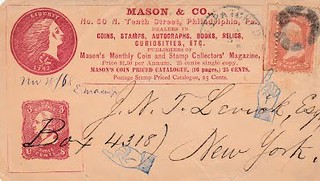
Working on a traveling exhibition he purchased thousands of coins throughout the eastern seaboard of the United States and Canada and resold them to two coin dealers, A. C. Kline, and Edward Cogan, and to the collectors Dr. Montroville Wilson Dickeson, and Joseph Napoleon Tricot Levick, all fellow residents of Philadelphia. At last, Mason became a full-time coin dealer opening a shop at 434 Chestnut Street, Philadelphia, where he published a monthly magazine devoted to the hobbies of coins, postage stamps and other collectibles such as minerals, rare books, autographs, paper money, Indian relics, fossils, memorabilia and anything considered a novelty or curiosity fashionable at that time for hobbyists forming a collectors’ cabinet.
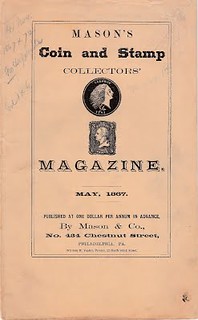 He began publishing his hobby magazine during the early Reconstruction Period in April 1867, on the second anniversary of the end of the Civil War. Consequently his publications are an invaluable primary resource for American historians, researchers and specialists in the Reconstruction Period, American literature, American archaeology and anthropology, American numismatics, U. S. and foreign philatelics, dealers and collectors of rare books, autographs, paper money, Indian relics and Americana.
He began publishing his hobby magazine during the early Reconstruction Period in April 1867, on the second anniversary of the end of the Civil War. Consequently his publications are an invaluable primary resource for American historians, researchers and specialists in the Reconstruction Period, American literature, American archaeology and anthropology, American numismatics, U. S. and foreign philatelics, dealers and collectors of rare books, autographs, paper money, Indian relics and Americana.
Subscribers to Mason’s publications were from coast-to-coast and included several foreign countries: Canada, England and Malta, and included many prominent numismatists. The correspondence published monthly reveals a wide range of demographic diversity among the subscribers clearly exhibiting that the subject matter appealed to men, women and young adults from diverse socio-economic backgrounds throughout the country. Mason launched his mass media vehicle transforming the realm of hobbies, where wealthy and poorer classes alike both enjoyed what was formerly considered a king’s pass time for recreational amusement, fun and enjoyable enthusiastic study.
To read the complete article, see:
MASON, EBENEZER LOCKE, JR
(https://sites.google.com/a/numismaticmall.com/www/numismaticmall-com/mason-ebenezer-locke-mason-jr)
The entire inventory of the Lupia Numismatic Library is for sale. Since neither the Chapman Family Correspondence Archive as a whole nor that of Hiram Edmond Deats could find an institutional or private buyer they shall, unfortunately, be broken up into parcels and sold from the NumismaticMall.com.
Every item in the Deats and Chapman Archives will be sold to anyone bidding a fair market price. Individual items will be available before the remaining archives are broken up into parcels sold at philatelic auctions in the U. S. and Hong Kong.
Check NumismaticMall.com frequently as dozens of new items with estimates will be posted daily beginning August 21, 2017 until everything is sold lock stock and barrel. Many treasures and surprises will be found, so keep looking.
All inquiries will be given prompt and courteous attention. Write to: john@numismaticmall.com .
MINT DIRECTOR PHILIP DIEHL AT 2017 DENVER ANA
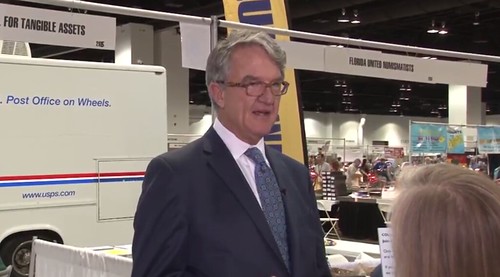

Philip Diehl, 35th Mint Director of the United States. Mr Diehl talks about his background and achievements in office while he was Mint Director including the 50 State Quarter Program.
To watch the complete video, see:
CoinTelevision: Philip Diehl Signs Autographs at Denver ANA. VIDEO: 5:07.
(https://www.youtube.com/watch?v=tXYW3ZaUnpw&feature=youtu.be)
CCAC PUBLIC MEETING SEPTEMBER 19, 2017
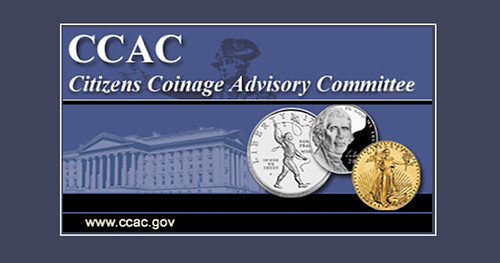
The Citizens Coinage Advisory Committee (CCAC) will be holding a meeting with the public on Tuesday, September 19, 2017, from 10 a.m. to 3 p.m. at the second-floor conference room of the United States Mint in Washington, DC. Attendees will be meeting to discuss the candidate designs of the 2019 America the Beautiful Quarters Program in addition to the design of the Office of Strategic Services Congressional Gold Medal. Members will also be reviewing and approving annual reports. If any member of the public is unable to attend the meeting in person, they may dial (866) 564–9287 and enter the access code 62956028 to listen in. To keep up with any meeting time changes or updates, interested persons should call the CCAC HOTLINE at (202) 354–7502.
For those who will be attending the meeting in person, Conference Room A&B can hold up to 50 members of the public at any one time and seats are available on a first-come, first-served basis. Those who will be attending should plan ahead of time to go through standard security procedures for a United States Mint building. These procedures include consenting to a thorough search of one’s person and objects upon entering and leaving the building. In addition, weapons, illegal drugs, contraband, and paraphernalia are prohibited from being carried into the building. A United States Mint Police Officer will be performing the screening according to federal law and any items determined not to meet regulations will be confiscated and subsequently disposed of. Needless to say, it would probably be best to bring nothing but clothes and curiosity.
CCAC’s role includes three major functions. The first is to advise the Secretary of the Treasury about any design proposals regarding bullion coinage, Congressional Gold Medals, and circulating coinage. Next, CCAC is to advise the Secretary of the Treasury about what persons, places, or events are to be minted on commemorative coinage. Lastly, CCAC makes recommendations for the mintage level of any commemorative coins issued. Those who have any additional questions are advised to contact Betty Birdsong, Acting United States Mint Liaison to the CCAC, at (202) 354–7200.
To read the complete article, see:
Citizens Coinage Advisory Committee to hold public meeting on September 19
(http://news.coinupdate.com/citizens-coinage-advisory-committee-to-hold-public-meeting-on-september-19/)
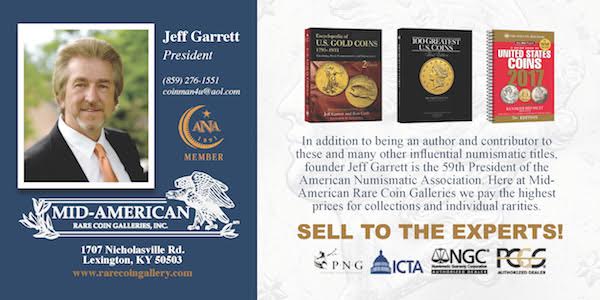
INTRODUCING PEOPLE TO COIN COLLECTING
To read the complete article, see:
Ultimate Beginners Guide to Coin Collecting
(https://www.smarterhobby.com/coin-collecting/)
Can numismatics survive without kids?
The short answer is yes.
The long answer is it’s complicated.
Historically, there have been two portals to entry to numismatics.
Youth is one of them.
The other portal to entry is middle age.
It is a time when the next generation of kids has gone off to college.
The spouse is engaged in one activity or another.
The other partner has time to spend on an activity of his or her own.
Coins look appealing.
The root of interest could be deep in childhood.
Interest might be due to a gold bullion coin commercial seen on cable TV.
Maybe it is due to receipt of a challenge coin while serving in the military.
The military has provided many an accomplished collector.
Knowing that there are these two paths to entry, organized numismatics has spent decades sponsoring Young Numismatists programs.
There has been virtually no attention paid to the entry point at middle age – except by marketers.
They are selling gold bullion coins to the middle-aged.
They are selling gold-plated state quarters.
They are selling medals made of silver supposedly recovered from the World Trade Center after the twin towers crashed to the ground.
Organized numismatics only pays attention to these numismatic novices when they knock on our door to resell what they have purchased.
Why do we not have a program to convert these individuals to coin collecting?
It won’t be easy.
It is far easier to collect donations on the bourse floor for cute 10-year-old kids than middle-aged lawyers or doctors.
Yet in the 150 years of modern numismatics, it is precisely those middle-aged lawyers and doctors who were the backbone of numismatics.
We need a modern outreach to them.
To read the complete article, see:
Can numismatics ignore the kids?
(http://www.numismaticnews.net/buzz/can-numismatics-ignore-kids)
KAGINS SEPTEMBER 2017 SALE HIGHLIGHTS
Complete Variety Set of Nine $50 Humbert “Slugs” Featured in Kagin’s West Coast Auction
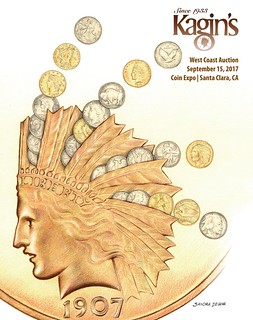 A complete nine piece set of Augustus Humbert U.S. Assay Office $50 gold pieces are highlighted in the September 15, 2017 West Coast Auction in conjunction with the Santa Clara Expo coin convention held at the Santa Clara, California convention center. All Kagin varieties (listed in Private Gold Coins and Patterns of the United States, Arco Publishing 1981) are offered for sale individually.
A complete nine piece set of Augustus Humbert U.S. Assay Office $50 gold pieces are highlighted in the September 15, 2017 West Coast Auction in conjunction with the Santa Clara Expo coin convention held at the Santa Clara, California convention center. All Kagin varieties (listed in Private Gold Coins and Patterns of the United States, Arco Publishing 1981) are offered for sale individually.
“This is the first time in over a decade that all the $50 gold varieties are for sale in an unreserved public auction”, explained Don Kagin, president of Kagin’s Auction, a division of Kagin’s, Inc. “We’ve held well over 350 auctions since 1940 and I don’t remember the last time we were privileged to offer this many Humbert “slugs”, let alone, all the varieties,” he ventured.
According to the catalogers, the Yerba Buena (the original name of San Francisco) Collection was assembled over 25 years and comprises some of the finest specimens known including examples from the Clifford-Kagin collection—one of the finest and most comprehensive pioneer gold collections prior to it being privately sold in the early 1990s.
With the advent of the discovery of gold in January, 1848 in Coloma near present day Sacramento, California, thousands of prospectors rushed to San Francisco to mine the new gold fields. Others came to provide goods and services to an exploding population. Soon it became obvious that the use of gold dust and nuggets in trade was difficult and inaccurate. There was a critical need for a better medium of exchange--coins. By May, 1849 a number of private coining firms had opened up in Benicia, Sacramento and San Francisco. But many of them issued coins later found to be worth less than their face value. Merchants and bankers clamored for Government intervention by establishing a federal branch mint.
In a compromise with the powerful Congressional delegations from Pennsylvania, which already had a mint in Philadelphia, and New York whose representatives wanted their own mint, the California faction was able to pass a bill providing for a Provisional Mint which would act like a regular mint but without the coins having legal tender status.
 In January, 1851, Augustus Humbert arrived in San Francisco as the U.S. government official U.S. Assayer of Gold for the new U.S. Assay Office in San Francisco. Humbert brought with him dies for a $50 gold piece and contracted with the most reputable private gold firm, Moffat & Co, to melt down, assay and strike new coins for commerce in California. The first coins that the Assay Office struck were eight sided 2 ½ ounce gold pieces soon dubbed “slugs”.
In January, 1851, Augustus Humbert arrived in San Francisco as the U.S. government official U.S. Assayer of Gold for the new U.S. Assay Office in San Francisco. Humbert brought with him dies for a $50 gold piece and contracted with the most reputable private gold firm, Moffat & Co, to melt down, assay and strike new coins for commerce in California. The first coins that the Assay Office struck were eight sided 2 ½ ounce gold pieces soon dubbed “slugs”.
One of the more elusive specimens in the Kagin’s West Coast Auction is one of those first issued--the 1851 .880 K-1 Lettered Edge variety with “50” on the reverse. The “50” and all eight edges were hand- struck with the lettering AUGUSTUS HUMBERT UNITED STATES ASSAYER OF GOLD CALIFORNIA 1851. The auction specimen is described as NGC MS-61 from the Clifford-Kagin collection.
Another lot is from the shipwreck, S.S. Central America and sports the distinctive gold label. It is described as an 1852 .887 Thous. target reverse Reeded Edge K-11 and graded PCGS AU-55 CAC.
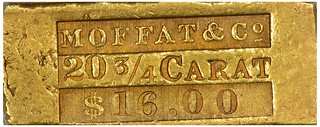 Besides the Yerba Buena Collection the sale includes many more California pioneer gold pieces highlighted by the rare and popular $16 1849 Moffat & Co. ingot from the famous Louis Eliasberg, Sr. collection.
Besides the Yerba Buena Collection the sale includes many more California pioneer gold pieces highlighted by the rare and popular $16 1849 Moffat & Co. ingot from the famous Louis Eliasberg, Sr. collection.
The auction is available online at www.kagins.com or a free catalogs of this upcoming auction which also offers much shipwreck artifacts and coins including a complete set of S.S. Central America gold Ingots, Hobo Nickels, The finest known Gem Proof $5 1860 and other U.S. Federal coinage and Americana, email info@Kagins.com, or call 888-8kagins (852-4467).
NUMISMATIC AUCTIONS SALE #61 SEPTEMBER 25, 2017
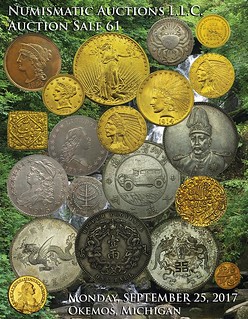 The catalog for Numismatic Auctions LLC Sale #61 represents a legion of diverse numismatic holdings. You will find within this catalog a great mix of United States, Canadian, Ancient and World Coins, Paper Money, Tokens & Medals and other material for your bidding pleasure. Should you be considering consigning to the next upcoming catalog, the Spring 2018 Auction Sale #62, the deadline for consigning is Nov. 27, 2017.
The catalog for Numismatic Auctions LLC Sale #61 represents a legion of diverse numismatic holdings. You will find within this catalog a great mix of United States, Canadian, Ancient and World Coins, Paper Money, Tokens & Medals and other material for your bidding pleasure. Should you be considering consigning to the next upcoming catalog, the Spring 2018 Auction Sale #62, the deadline for consigning is Nov. 27, 2017.
Sale #61 features a myriad of material from the United States & abroad over a vast time frame from Ancient to Modern. Among the many highlights are rare numismatic items from The Andrew L. Tuttle Memorial Museum Collection of Rare Chinese Coins, The Myron Xenos Money Tree Collection of 8 Reales and several other fine consignments. This sale features a neat run of US type and series coins, partial sets and more from Half Cents to Dollars. The group contains a number of great collector coins, especially in the realm of Large Cents and Early Half Dollars from Flowing Hair to Capped Bust and Seated Coinage. The US Coin listing is finalized by a strong mix of high grade certified Silver Dollars, Gold and Modern American Eagle Coinage, Patterns, Paper and Exonumia as well as Key So-Called Dollar Rarities from the Don Ensley Collection.
The Canadian segment provides a pleasing grouping of minors by date and variety plus a sizable group of Silver Dollars, many certified and raw collector grades plus Maritimes, tokens and more. The World selection starts with an interesting Ancient ensemble from a very old collection and then presents an impressive offering of Chinese, German, English and Mexican to Latin American material along with other World coinage in singles, sets and small group lots.
The catalog goes on with specialized ensembles of Early Indian coinage as well as Rare British India Proofs, Eastern and Asian countries, a vast array of international coinage along with intriguing study lots. In the midst of an amazing array of coins is a fine Swedish Medal collection from the American Swedish Institute and much, much more. As usual we bring our signature large bulk lots under the hammer to round out the sale alongside tokens, medals & paper money. Feel free to visit our website at www.numismaticauctionsllc.com or order your complimentary published catalog by contacting us today!
Steven L. Davis
Numismatic Auctions L.L.C.
P.O. Box 22026
Lansing, MI 48909
USA
www.numismaticauctionsllc.com
Phone: 517-394-4443
Fax: 517-394-0579
Email: numauctionsllc@aol.com
GORNY & MOSCH FALL AUCTIONS 249-251
October 11-13, 2017, October 15, 2017 Gorny & Mosch Auctions 249-250, E-Auction 251
Continental Dollar at Gorny & Mosch
October 11-13, 2017, Gorny & Mosch will conduct their Fall Auctions, offering ancient to world coins and medals. The B-Auction featuring the less expensive material as well as the multiple lots will take place as an e-auction on October 15, 2017.
October 11-13, 2017, Gorny & Mosch will conduct two sales. Auction 249 focuses on ancient coins, auction 250 on world coins and medals from medieval and modern times. The three days will witness a broad selection of offers, with many rarities and something in store for every collector. The top item of the catalog of ancient coins is a Siculopunic tetradrachm featuring the head of Tanit, which used to be misinterpreted as a portrait of Dido.
Among the coins from modern times, an extremely rare “Continental Dollar” stands out, which was produced in the United States of America in 1776 as the year they emerged.
For the first time, the less expensive material and the majority of multiple lots – dating from antiquity, medieval and modern times – will be called out in an e-auction, to be conducted on Sunday, October 15, 2017, starting at 10 a.m.
For more information, see:
https://www.gmcoinart.de/
Auction 250 includes Coins from medieval times, German coins and medals, World Coins, Transylvania, and a Continental Dollar.
E-Auction 251 includes ancient to world coins and medals.
Here are a few selections. -Editor
Lot 13: Celtic "Rainbow Bowl"
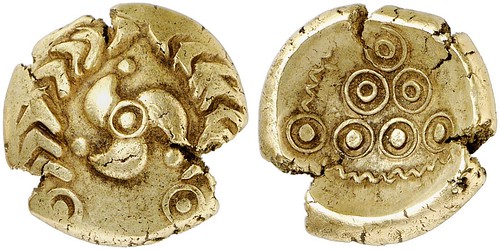
CELTS | GERMANY | HESSES AND RHINELAND.
Nord Group. "Rainbow Bowl" (7.00g). 50 - 25% Chr. Vs .: Triskeles in a wreath. Rs .: Seven pyramid-shaped circles arranged in a wreath. Waiter IX b; ECR 556; Castelin 1097; Flesche 402. Electron!
To read the complete lot description, see:
Lot 13
Nord Group. "Rainbow Bowl"
(https://auktionen.gmcoinart.de/Auktion/Onlinekatalog?id=485&los=1318062)
Lot 123: Hemistater of Hieron II
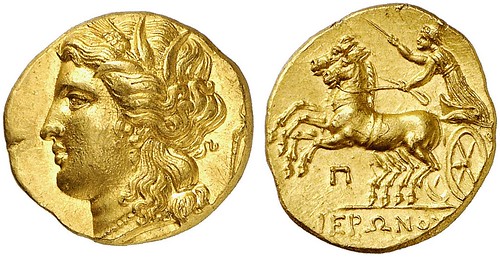
GREEKS | SICILY | SYRACUSE
Hieron II, 274-216 BC, Chr. Hemistater (4.27g). Approximately 220 - 217 v. Chr. Vs .: head of Persephone with earring, earring and necklace nl, behind burning torch. Rs .: ???O??S, wagon steering galloping biga nl, in the raised R. driving rod, under the horse ?. SNG ANS 865-867 var .; BMC 511-521 var .; Carroc
To read the complete lot description, see:
Lot 123
Hieron II, 274-216 BC, Chr. Hemistater
(https://auktionen.gmcoinart.de/Auktion/Onlinekatalog?id=485&los=1318062)
Lot 2272: 1705 1 1/2 Reichstalern of Anton Ulrich
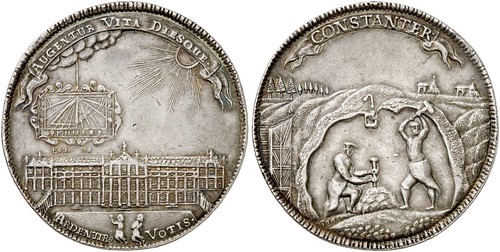
GERMANY UP TO 1871 BRAUNSCHWEIG - WOLFSBÜTTEL
Anton Ulrich, 1685 - 1714. Solver to 1 1/2 Reichstalern 1705, Zellerfeld. On the visit of the Duke in the Zellerfelder coin. Sundial hanging from clouds and sun shining above the Saltdahlum Castle, in front of which two kneeling and praying miners / two miners working in Bergwerkslandschaft, above CONSTANTER. Fiala 990. Welter 2289 C. Knyph. 848. Of great rarity.
To read the complete lot description, see:
Lot 2272
Anton Ulrich, 1685 - 1714.
(https://auktionen.gmcoinart.de/Auktion/Onlinekatalog?id=485&los=1318062)
Lot 3483: 1776 Continental Dollar in Tin

AMERICA | UNITED STATES (USA) Continental currency
American Congress Tin Continental Dollar 1776. A sun whose rays shine on a sundial, including MIND YOUR BUSINESS (Thinking of your task). To the left of the sun in the circle the latin FUGIO (the time flies fast), transcribed CONTINENTAL CURRENCY, and the year 1776 / In the inner circle the font WE / ARE / ONE (therefore we are one), therefore AMERICAN CONGRESS, therefore a firmly linked chain from 13 members, the names of the then 13 member states of the American Confederation. The 13 member states were: N. HAMP, S; Masach; CONNECT.T; R. ICELAND; N. YORK; N. JERSEY; PENNSILV; DELAWARE; MARYLAND; VIRGINIA; N. CAROLIN; S. CAROLIN; and GEORGIA. Newman 3 D. Breen (Complete Encyclopedia) 1095. Of the greatest rarity. NGC MS 60, No. 437837-001.
To read the complete lot description, see:
Lot 3483
American Congress Tin Continental Dollar 1776.
(https://auktionen.gmcoinart.de/Auktion/Onlinekatalog?id=485&los=1318062)
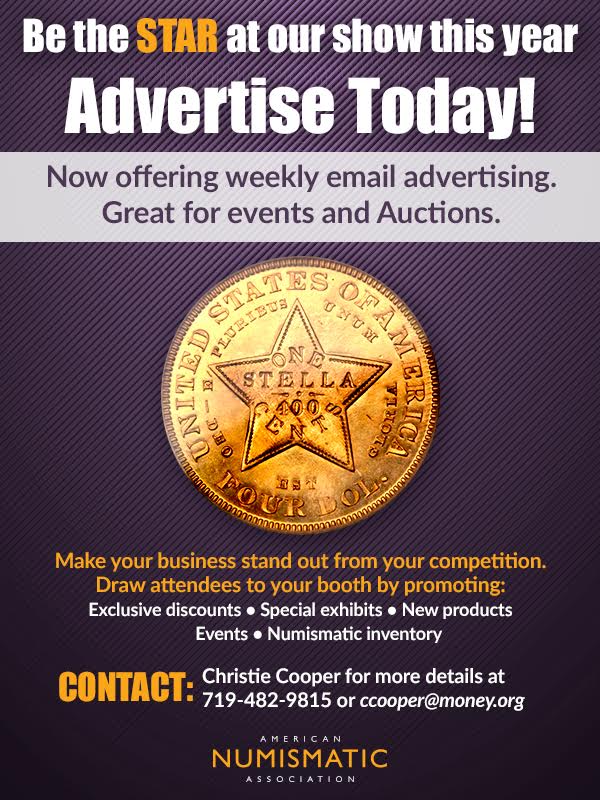
NUMISMATIC NUGGETS: SEPTEMBER 10, 2017
1855 Exposition Universelle De 1855 Paris Medaille D'Honneur
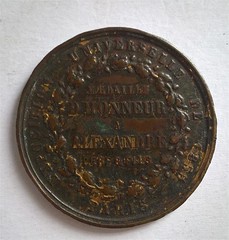
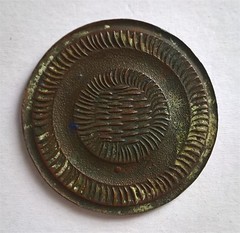
Description: Exposition Universelle De 1855 Paris Medaille D'Honneur Alexandre Pere & Fils, Bronze Token, 45mm Diameter
To read the complete lot description, see:
(https://www.invaluable.com/auction-lot/-1-c-C874B0F84F)
Swiss Gold: Benedictio Dei Diiat
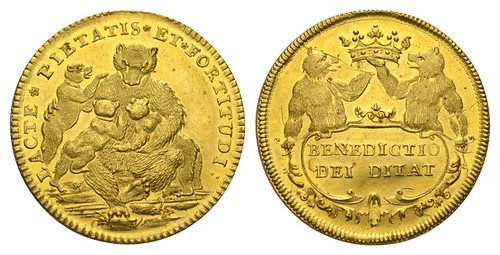
Switzerland / Switzerland BERN. Goldmedaille to 6 ducats oJ by HJ Burckhard, Säugender Bär, MH VAR. Missing SM 693 34.2 mm, 20.68 g of the greatest rarity FDC
To read the complete lot description, see:
LOT.NO:130Bern OJ
of the greatest rare
(https://www.muenzenonline-auktion.ch/catalogDetail/detail/e-live-auction-6-1503326743/Bern-O.J--1504088264)
Band of Hope Temperance Medal

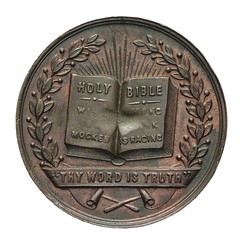
BAND OF HOPE TEMPERANCE MEDAL PROMISE TO ABSTAIN FROM ALL INTOXICATING DRINKS
To read the complete lot description, see:
BAND OF HOPE TEMPERANCE MEDAL PROMISE TO ABSTAIN FROM ALL INTOXICATING DRINKS
(http://www.ebay.co.uk/itm/BAND-OF-HOPE-TEMPERANCE-MEDAL-PROMISE-TO-ABSTAIN-FROM-ALL-INTOXICATING-DRINKS/362093146381)
Windsor Canadian Imported Whisky Encased Cent
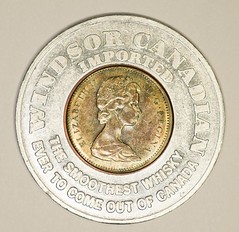
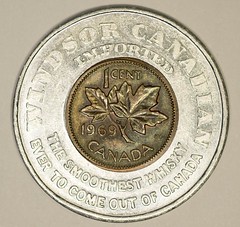
Windsor Canadian Imported Whisky Never Go Broke / Good Luck Token Canadian 1969 Cent
To read the complete lot description, see:
(https://www.invaluable.com/auction-lot/-1-c-8374B5CB5F)
Lot 291: Windsor Canadian Imported Whisky Never Go Broke / Good Luck Token Canadian 1969 Cent
Commemorative Gold-Plated Copper "Bitcoin"
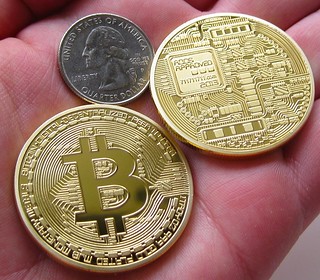 .999 Fine Gold Bitcoin Commemorative Round Collectors Coin - Bit Coin is Gold Plated Copper Physical Coin
.999 Fine Gold Bitcoin Commemorative Round Collectors Coin - Bit Coin is Gold Plated Copper Physical Coin
To read the complete lot description, see:
.999 Fine Gold Bitcoin Commemorative Round Collectors Coin - Bit Coin is Gold Plated Copper Physical Coin
(https://www.amazon.com/Gold-Bitcoin-Commemorative-Round-Collectors/dp/B00J2B0KEO/ref=as_li_ss_tl)
SELECTIONS FROM THE FEISEL OCTOBER 2017 SALE
Special Section #1 – OKLAHOMA / OT / IT (lots 1-219 – from an old time collection)
Special Section #2 – BBC – TYPE TOKENS (lots 220-352 – more from the Richard Magnuson collection)
Special Section #3 – OKLAHOMA / OT / IT (lots 353-396 designed to complement Special Section #1)
Special Section #4 – COLORADO
and finally GENERAL SECTION (lots 489-907)
The General Section provides the usual assortment of exonumia, but this time there are a number of Encased, Elongated, and Counterstamped coins, Love Tokens, and Civil War Cents. Scattered in the various Sections are a number of very rare military tokens. There is the usual scattering of topical collection interests such as saloon, pool/billiard, Ingle, coal, lumber, transportation, and more!
Lot 31: Oklahoma Territory Token
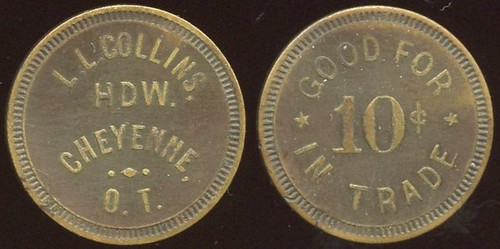
OKLAHOMA
Lot 31: L.L. COLLINS / HDW. / CHEYENNE, / O.T. // Good For / 10¢ / In Trade, br rd 22mm. Listed 10 $350. Extremely rare locality! G3-EV$250/500-MB$200
Lot 374: 1 Hide Token
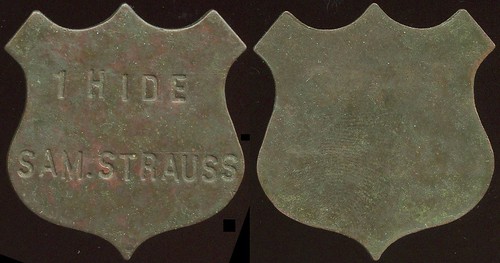
OKLAHOMA - Military
Lot 374: 1 HIDE / SAM. STRAUSS (a/i) // (uniface), (Fort Sill), br shield 39x42mm, dark patina. Listed 860 $750; Cunningham OK560 $750. G3-EV$600/1,200-MB$450
Lot 534: I. J. Hicks Political Token

ARKANSAS
Lot 534: COMPLIMENTS OF / I.J. HICKS / (h/am) CANDIDATE FOR / COUNTY CLERK / YOUR SUPPORT SOLICITED // You Can’t Hold Me / (h/am) (men with horses), (Little Rock), al ov sc-22 30x25mm. Numerous Internet references for Hicks. Unusual item! G5-EV$75/150-MB$50
Lot 787: Encased Liberty Nickel
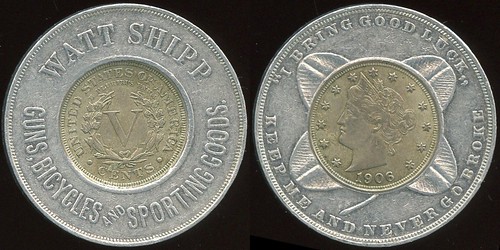
ENCASED COIN - Oregon
Lot 787: WATT SHIPP / (nickel 1906) / GUNS, BICYCLES AND SPORTING GOODS. // “I Bring Good Luck” / (nickel) / Keep Me And Never Go Broke, (Salem), al rd 38mm. G3-EV$150/300-MB$100
Lot 855: Love Token
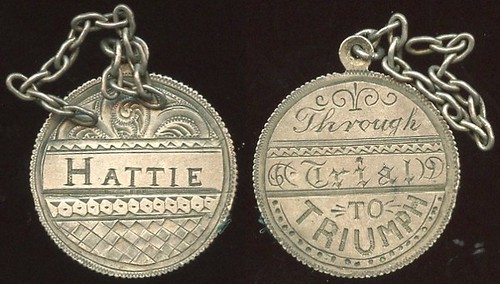
LOVE TOKEN
Lot 855: Elaborate engraving with HATTIE, reverse engraved THROUGH / TRIAL / TO / TRIUMPH, on silver coin 18mm, added loop and chain. There has to be story behind this one! G4-EV$50/100-MB$40
Lot 877: A. GLEASON Token

CIVIL WAR CENT - Merchant
Lot 877: A. GLEASON / (eagle on branch) / 1863 / MANUF’R, HILLSDALE // Farnams / Bronchial / Tablets, (MI), br rd 20mm, tiny rim clip. Listed Rulau 450D-1A “rare.” G3-EV$600/1,200-MB$500
Duane H. Feisel
PO Box 212
Shingletown, CA 96088
(530) 474-4168
dhfeisel@frontier.com
To view the lot images, see: http://tinyurl.com/y8ec7a8k
QUERY: HARASSMENT OF THE NUMISMATIST MEDAL
Philip Mernick of London writes:
A curious medal die just finished on eBay (I was the underbidder). The die came from the Edinburgh firm of A. Kirkwood and Son, according to the seller, but what is it about? It mentions an Executive Order which sounds more like the USA. Does any E-Sylum reader know what was on the other side, assuming the die was used?

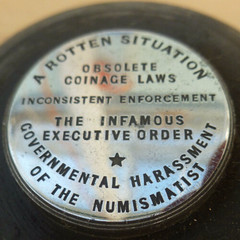
OBSOLETE
COINAGE LAWS
INCONSISTENT ENFORCEMENT
THE INFAMOUS
EXECUTIVE ORDER
GOVERNMENTAL HARASSMENT
OF THE NUMISMATIST
To read the complete article, see:
(http://www.ebay.co.uk/itm/Rare-Commemorative-Medal-die-with-Coin-numismatist-interest-Govt-Harrassment-/311951139548)

HAMMERED ENGLISH PENNIES FOUND NEAR CARLISLE
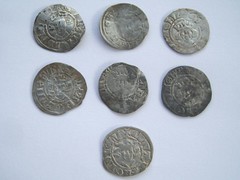

Treasure in the form of seven hammered silver coins has been found in the Carlisle area.
The collections of pennies, which date back to 1280 - 1307 during the reign of King Edward I, were found by metal detecting enthusiast Ian Hughes.
The 64-year-old of Belle Vue, Carlisle, has been metal detecting for more than 30 years.
"Once I found more than two I knew it was going to happen [they would be deemed treasure]," he said.
"You just get a kind of buzz. Not so much because you are finding silver or gold. It's just the history behind it.
"You are the first person to hold it within 700/800 years."
To read the complete article, see:
Treasure dating back more than 700 years found in Carlisle
(http://www.newsandstar.co.uk/news/Treasure-dating-back-more-than-700-years-found-in-Carlisle-366cbf78-5138-499d-9993-b8f4c66819b8-ds)
ROYAL CANADIAN MINT HOT AIR BALLOON COIN
 The Royal Canadian Mint’s latest release of collector coins continues to showcase Canada using creative shapes, sophisticated applications of colour and selective gold plating on its numismatic keepsakes, which are now available for purchase.
The Royal Canadian Mint’s latest release of collector coins continues to showcase Canada using creative shapes, sophisticated applications of colour and selective gold plating on its numismatic keepsakes, which are now available for purchase.
By turning its popular egg-shaped coins upside down, the Mint has created a novel and fitting tribute to Canada’s numerous ballooning festivals on the 2017 $20 Fine silver coin, “Hot Air Balloons.” Designed by artist Calder Moore, it features a vibrantly coloured scene of a balloon flotilla, including one displaying a red and white maple leaf design, which rises above a majestic Canadian landscape on a perfect summer morning. This $20 coin has a weight of 31.82 grams, a 45 mm long by 33 mm wide diameter and a mintage of 5,000 pieces.
FIRST FLIGHT OF 1783
Beautiful colour has been a signature feature of hot air balloons since the first flight of 1783. Inventors Joseph-Michel and Jacques-Étienne Montgolfier worked with wallpaper manufacturer Jean-Baptiste Réveillon to build their 1,700-cubic-metre taffeta envelope, and Réveillon brought a strong sense of aesthetics to the project when he created a blue and gold design of flourishes, suns and zodiacs—and that is likely how the tradition of beauty took off.
The first passengers aboard a hot air balloon were a sheep, a duck and a rooster. They took to the air on Sept. 19, 1783, two months before the first manned flight in Paris.
The first hot air balloon in Canada was launched during the War of 1812 as a military post to observe American troops along the Quebec border.
To read the complete article, see:
New Issue: RCM September catalogue continues celebration of Canadian symbols
(http://canadiancoinnews.com/new-issue-rcm-september-catalogue-continues-celebration-canadian-symbols/)
'SILVER' PENNY COIN COULD BE RARE ERROR
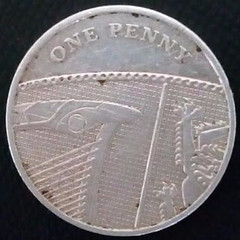 Dad finds incredibly rare silver 1p in his small change - and it could sell for thousands.
Dad finds incredibly rare silver 1p in his small change - and it could sell for thousands.
After finding his coin, Stephen, 35, from Wales, decided to stash it away - however now he believes it could be worth a mint.
Elizabeth Beckford, at Chards, the world's biggest buyer of gold and silver told Mirror Money that while the coin will need to be tested and valued for accuracy, there's belief it could be worth anything up to £2,000 or more because of its rarity.
"This 2011 penny may be an error coin which missed the copper-plating process. Exactly 431,004,000 pennies were released into circulation in 2011, so it is possible that some coins with striking errors were missed during quality control. However, we have not heard of any similar steel pennies so this may be an exciting find!
"It may also be a penny which was issued as a commemorative 'lucky' silver coin by the Royal Mint. These sterling silver pennies were issued as gifts for new babies and christenings. These coins were not meant for circulation but occasionally they are removed from the packaging and are used in change.
To read the complete article, see:
Dad finds incredibly rare silver 1p in his small change - and it could sell for thousands
(http://www.mirror.co.uk/money/dad-finds-incredibly-rare-silver-11120811)
David Pickup writes:
It is possible that it is a genuine silver penny that has got into circulation by mistake. As you will see these are common and only worth £10 or so.
The other explanation is it was issued without the cladding. This is unlikely but possible. However, in this country error coins are not really much in demand. If you look at eBay there are lots of error coins which sell for less than £20.00.
A friend of mine who is a dealer thinks it might be worth £80 to £100, certainly not £2,000.00.
To read the complete article, see:
Lucky Silver Penny Christening Baby Gift 2009 2010 2011 2012
(http://www.ebay.co.uk/itm/Lucky-Silver-Penny-Christening-Baby-Gift-2009-2010-2011-2012-/140872869025)
LIGHT BRIGADE MEDALS AT AUCTION
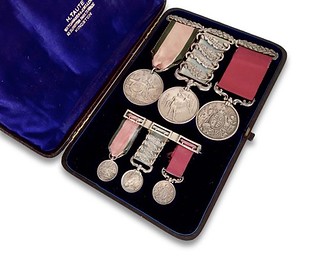 ‘Into the Valley of Death, rode the six hundred…’ He had a way with words, that Tennyson fellow. And the Charge of the Light Brigade he was writing about also has a stirring effect on militaria collectors.
‘Into the Valley of Death, rode the six hundred…’ He had a way with words, that Tennyson fellow. And the Charge of the Light Brigade he was writing about also has a stirring effect on militaria collectors.
The famous 1854 action in the Crimean War is one of the best-known British military blunders and it exerts a strong pull at auction, with medals from chargers among the most valuable to collect.
A group of three medals earned by a participant who survived the ‘volley and thunder’ is estimated at £10,000-15,000 at Laidlaw Auctioneers on September 30 in Carlisle.
There can be a problem with Charge of the Light Brigade memorabilia: many more people said they had taken part than actually did (a bit more than Tennyson’s six hundred, around 675, although he can be permitted a bit of poetic licence).
Laidlaw adds “our chap is a confirmed charger. The Crimea Medal is indeed correctly impressed TP SJT MJR J S BAKER 4th LT DRAGNS.”
The group on offer comprises Baker’s Crimea Medal with four clasps (Sebastopol, Inkermann, Balaklava, Alma), a so-called Turkish Crimea Medal and his Army Long Service and Good Conduct Medal.
“At or near issue they have been jeweller-mounted on a silver laurel suspender and presented in a fitted case with miniatures,” says Laidlaw, who adds that the vendor wishes to remain anonymous but he can confirm the group “has not previously appeared on the market”.
To read the complete article, see:
Charge of the Light Brigade medal group gallops into Carlisle auction
(https://www.antiquestradegazette.com/news/2017/charge-of-the-light-brigade-medal-group-gallops-into-carlisle-auction/)
1642 DUTCH CROWN AMONG ICEBREAKER'S COINS
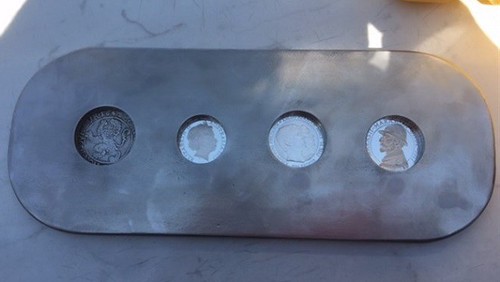
The first building block of Australia’s new icebreaker was welded into place at a keel laying ceremony at Damen Shipyard Galati in Romania late last month.
The concept design was done by Knud E. Hansen, and Managing Director, Finn Wollesen attended the ceremony, along with Rasmus Nygaard from Friends of Nella Dan. They came bearing a Danish coin, depicting the Danish Crown Prince Frederik, and his wife – Princess Mary, who originates from Australia.
The choice of another coin was also symbolic; it was a Dutch silver coin dated 1642, the year that Dutch explorer Abel Tasman become the first European to reach Tasmania. Tasmania is not only where the offices of the Australian Antarctic Division are located, but the island’s capital, Hobart, will be the vessel’s home port.
The heavy icebreaker was designed for the Australian Government to resupply their Antarctic bases and for research and scientific work.
To read the complete article, see:
Symbolic Coins Laid in Keel of Australia's New Icebreaker
(http://www.maritime-executive.com/article/symbolic-coins-laid-in-keel-of-australias-new-icebreaker)

$20 'MOVIE MONEY' BILL PASSED IN MISSOURI
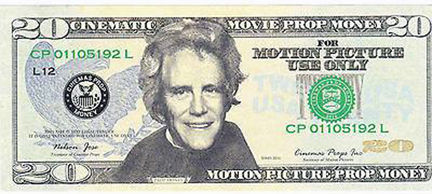
The Maryville Department of Public Safety received a report of a passed counterfeit bill over the weekend.
Obviously a fake, the bogus $20 note is apparently a prop of the sort used in movies and television shows.
The bill bears the likeness of a smiling Andrew Jackson along with the words “cinematic movie prop money, for motion picture use only” and “motion picture prop money” clearly displayed across the top and bottom.
According to the police, while the note appears phony even at a glance, it feels like the real thing and might easily pass as legal tender during a transaction in which it was included with, or hidden by, genuine bills.
Lt. Ron Christian said Tuesday that, so far as he knows, the prop-money twenty, passed at a local business, is the only reported counterfeit bill to surface locally over the past few days.
Late last month, the Associated Press filed a report about a $20 prop bill, similar to the one turned in locally, that was passed in Aliquippa, a city of 9,400 in western Pennsylvania.
To read the complete article, see:
‘Movie money’ counterfeit bill passed in Maryville
(http://www.maryvilledailyforum.com/news/article_c542b908-9274-11e7-bd03-3fb88e111f2e.html)
PRESERVING SEPTEMBER 11 ARTIFACTS
The history behind a single object can often tell many stories. In 2004 the museum acquired a stock certificate from an early Internet start-up. At first glance, you can probably imagine the types of stories we might tell with this object. However, when context places it in the World Trade Center on September 11, 2001, this stock certificate's history becomes much more complex.
Donated by Hoover, Inc., to the museum's Division of Work and Industry, the stock certificate is a reminder that the World Trade Center was a target, symbolically representing America's economic might and reach. The stock certificate is also a piece of reality, as fragments of paper rained down all across the city of New York following the collapse of the World Trade Towers.
Congress designated the museum as the official repository of the story of September 11, and the museum continues to collect artifacts that reflect what happened that day and the aftermath. How do you preserve the history of an object—especially a tragic history—and how does that history inform the conservation treatment the object receives in preparing it for potential display?
While the answers very much depend on the object in question, making this particular stock certificate's tumultuous history immediately obvious to the viewer is especially important. The certificate arrived in the Paper Conservation Lab as a pile of paper bits stored in the envelope and inert plastic sleeve shown below. Organization of these fragments was needed to make some order out of the chaos, to make the story of the certificate clear, and to provide a safer permanent storage solution.
To achieve these objectives, the fragments were categorized by charred paper color, ink lines, and shape to make the original size of certificate clear. Once staff members knew how to put it together, the intentional decision was made to place the pieces slightly apart—not fitting together quite perfectly—thus maintaining their history in demonstrating the destruction the attacks caused. This was accomplished by using something called solvent-set tissue paper. The tissue is coated with an adhesive that is not tacky at room temperature, but can be activated with ethanol. This allowed for the pieces to be placed in desired positions, secured with ethanol applied with a miniature paint brush, and then weighted down while the softened adhesive set to establish a strong connection. This process made organization and workability easier, as secured fragments wouldn't move around while adjusting others. The fragments can be seen on the tissue in the photos below.
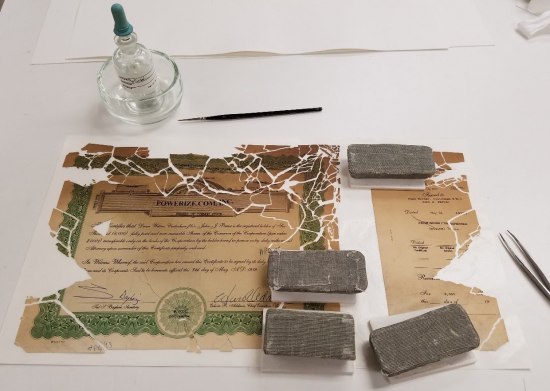
To read the complete article, see:
Preserving and displaying layers of history: The stock certificate nearly destroyed on September 11
(http://americanhistory.si.edu/blog/nearly-destroyed-september-11)
This is a difficult time for many Americans as well as throughout the world with storms and weather events that we will rarely see in our lifetimes and I just want to remind those of you in harms way to take proper precautions to protect your family, your home and your irreplaceable memories and personal property. Having been to banks and safe deposit box vaults around the world I want to remind everyone that vaults are not waterproof and you are responsible for the safety of your collection. Some of us have safe rooms etc, will the paper money survive but will it be damaged by dirty water-most likely. If you have water damage or such we have a fantastic restorer that understands paper money and can be of assistance if necessary.
Whether you live on a mountain or on the beach this would be a great time to review the safety of your collection.
NUMISMATIC TRAVEL QUIZ
Attention Lexinumiscryptographers:
You say you’ve been all over the world? Great!
Take a “Travel Quiz,” which has ten different letters. Use any or all of these letters to spell names of coins or denominations of money from any country, any era, any language, singular and/or plural.
Each letter occurs only once in “Travel Quiz,” so you can use a letter only once in each name. For example, “quarter” doesn’t work because it has two Rs. No slang, nicknames, abbreviations or symbols..
T R A V E L Q U I Z
How many did you get?
1 – 3 ? You is lying! You ain’t been off your couch in twenty years.
4 – 10 ? Your passport looks new and is mostly blank pages.
11 – 15 ? The crew recognize you when you board the plane.
16 – 21 ? They wave you through every customs post on the globe.
More than 21 ? You’re Marco Polo !
{Answers next week }
FEATURED WEB SITE: SMALL DOLLARS
This week's Featured Web Site is about U.S. Small Size Dollar Coins.
This web site is a comprehensive study of United States small size dollar coins that has been literally years in the making. It is a cumulation of information and collectables gathered over the past three plus decades. Besides the coins themselves, there are numerous items that help tell this fascinating story, many of them very collectable. Some of these items include autographs of the many people involved (including Susan B. Anthony), patterns and prototypes, documents, biographies of those involved, plus much, much, more. Edwin Johnston, Past-President of Greater Houston Coin Club, summarized this site fittingly when he said "The smalldollars.com website is a great place to recommend for a newbie collector who asks: 'What should I collect?'. It's very comprehensive in a very focused area that is at the same time, wide-ranging." (2/20/11)

http://www.smalldollars.com/

